34 Plant Favorites for a Picture-Perfect Cottage Garden
Are you overwhelmed by the thought of choosing the perfect flowers and plants for a charming cottage garden? Selecting the right plants is key to creating the beautiful cottage-style outdoor setting you’ve been dreaming of.
In this post, I’ll share my top plant favorites for that picture-perfect cottage garden you’ve always wanted to grow. Each plant on this list will add a touch of charm to your old-fashioned cottage garden.
Cottage gardens are known for their vibrant mix of flowering plants, thriving in an informal garden setting with minimal fuss and few rules. Let’s look at creating a garden with the feel of whimsy and everlasting color from spring through fall.
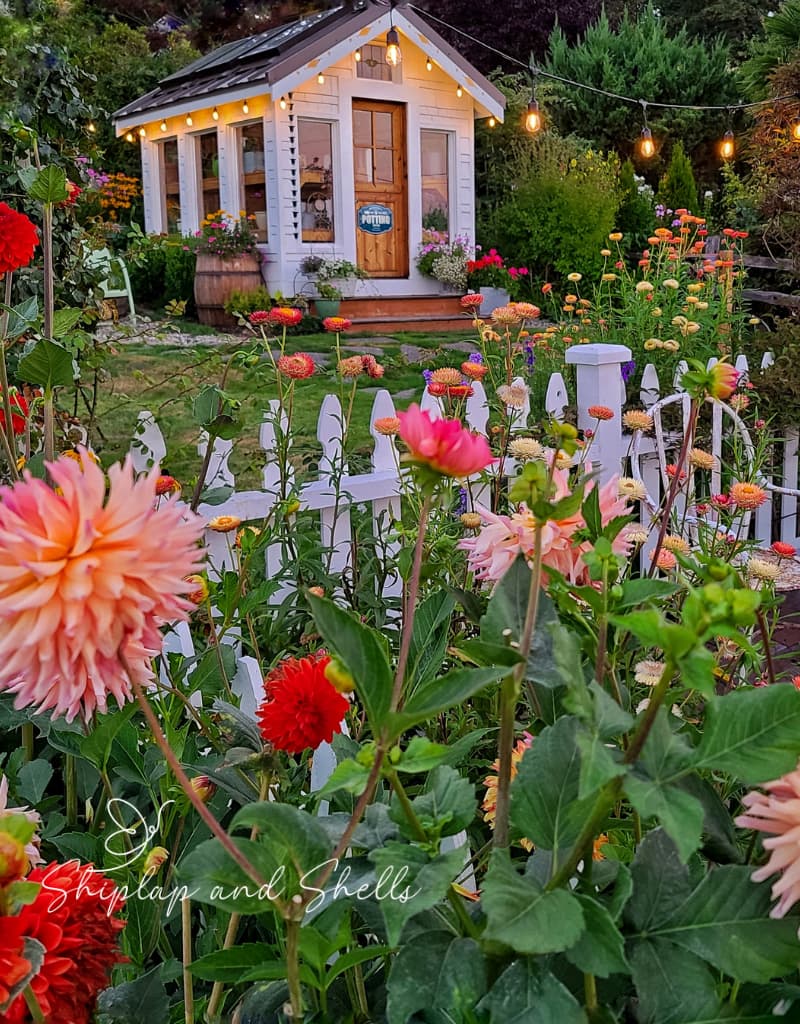
As an Amazon affiliate, I earn from qualifying purchases at no extra cost to you. My blog contains other affiliate links for your convenience as well. Click here to read my privacy policy.
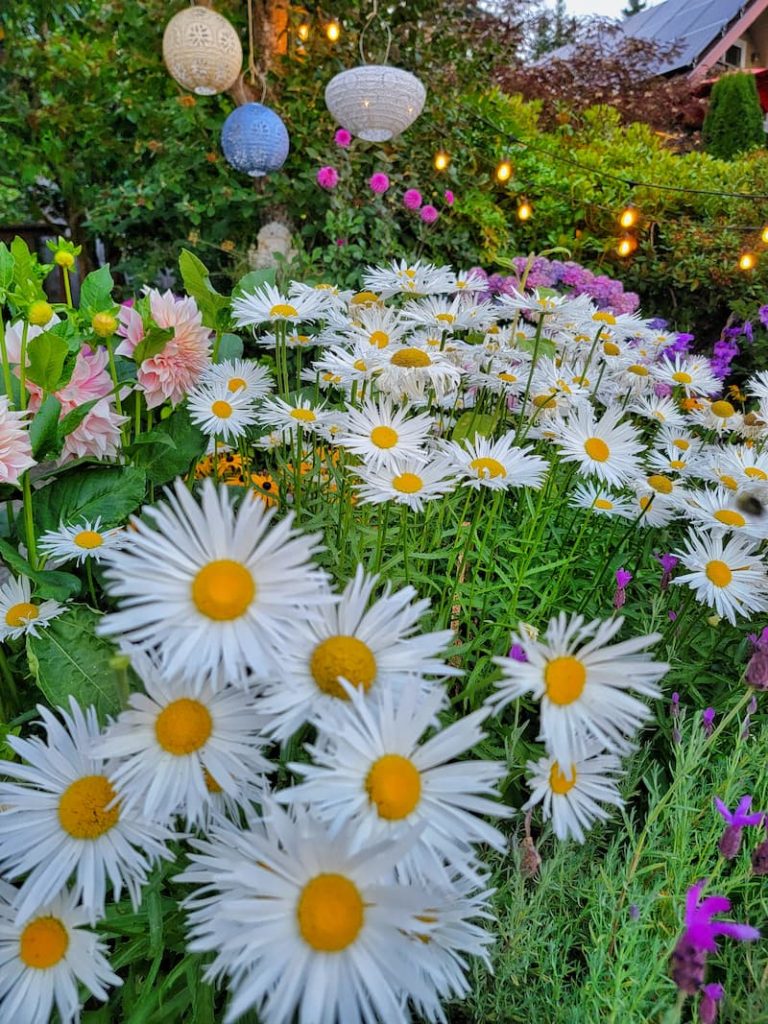
34 Best Cottage Garden Flowers and Plants
Can you picture it? That dreamy cottage garden you’ve always wanted to grow?
Imagine old-fashioned plant favorites like climbing roses and sweet peas growing on white picket fences and arbors, which give you a nostalgic cottage garden feel.
Discover a variety of cottage garden plants that add the most charming vibe to your outdoor spaces. From classic favorites to whimsical blooms, these plants breathe life into your garden.
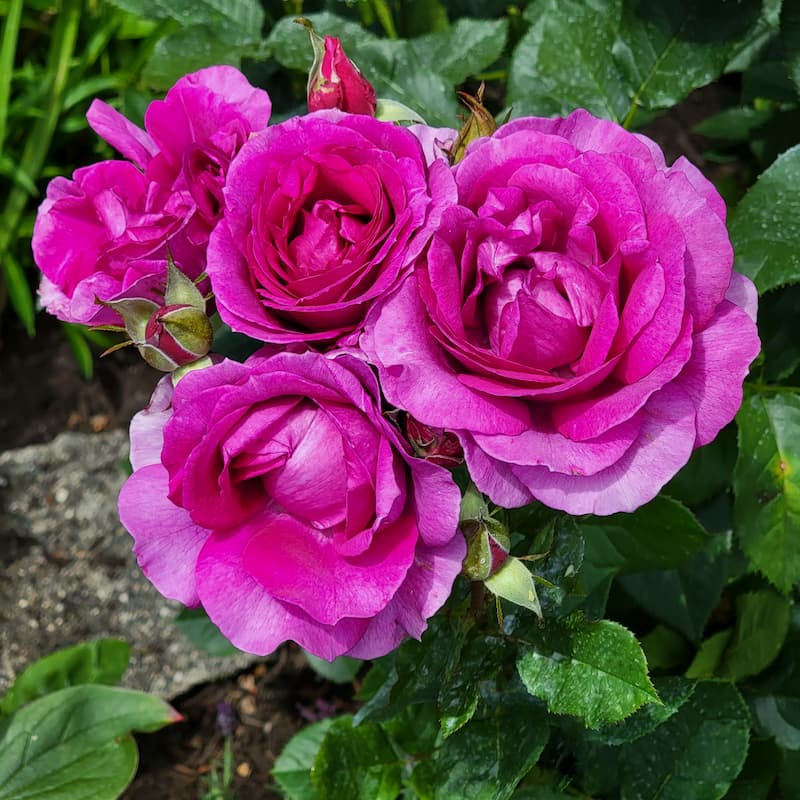
1. Roses
Old-fashioned roses are always at the top of the list when looking for flowers that bring beauty and charm to a cottage garden.
Their timeless elegance and romantic blooms make them perfect for this gardening style. With countless varieties available, you can choose from climbing roses cascading over arbors and fences, shrub roses that fill the garden with a burst of color, or delicate English roses with their old-world charm.
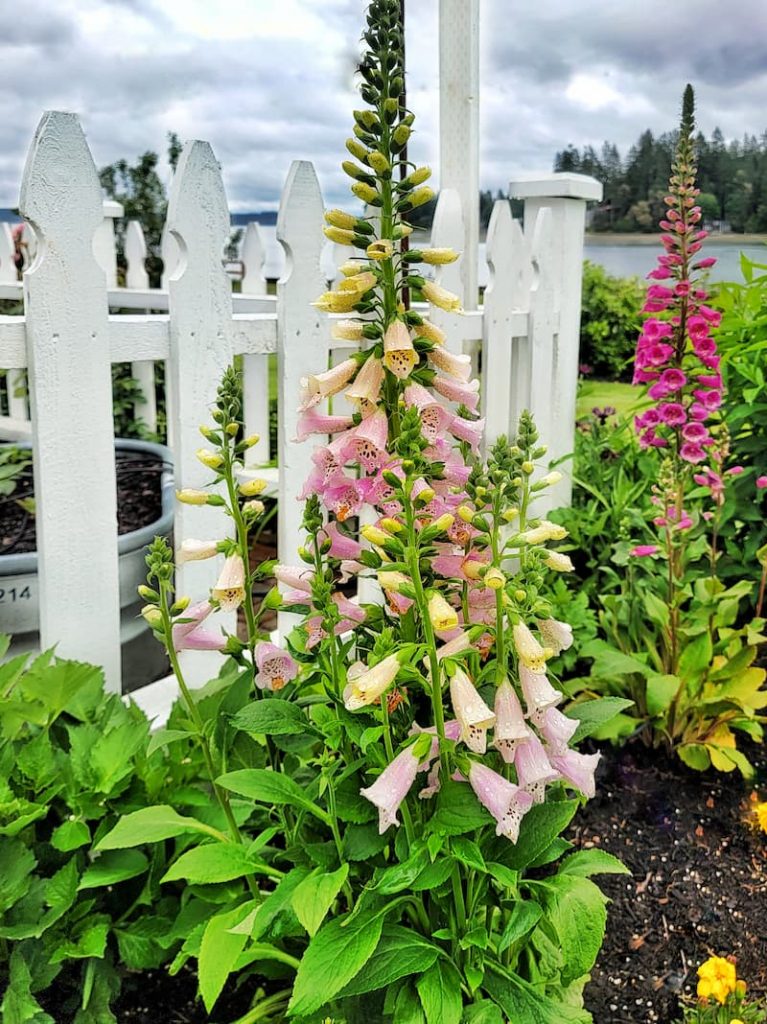
2. Foxglove (Digitalis)
When creating a whimsical cottage garden, foxgloves are a fabulous choice. These enchanting biennial plants add a touch of charm with their elegant spires and bell-shaped flowers.
Foxgloves come in various colors, including pink, purple, white, and bi-colored blooms. Their tall flower stalks rise above the foliage, adding vertical interest, and pollinators love them.
2. Foxglove
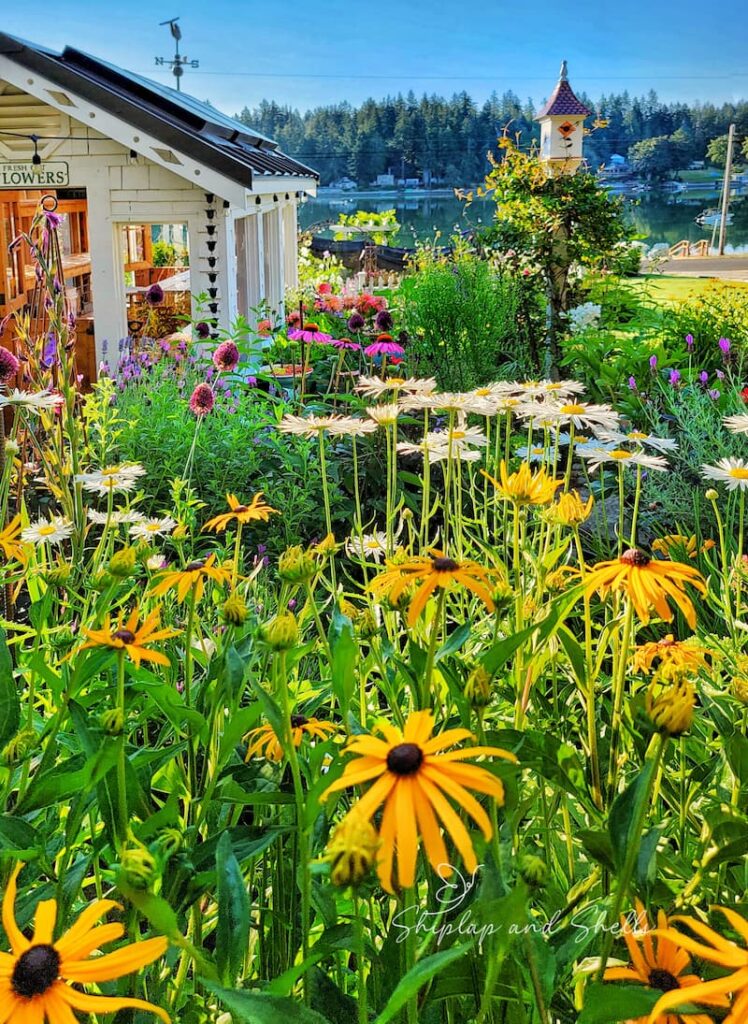
3. Black-Eyed Susans (Rudbeckia hirta)
Black-eyed Susans, with their cheerful golden blooms and daisylike appearance, are a wonderful addition to any cottage garden.
These versatile and low-maintenance perennial flowers bring vibrant color and a touch of rustic charm to your garden. Their bright yellow petals with contrasting dark centers create the most beautiful view.
Black-eyed Susans thrive in diverse soil conditions, making them a reliable choice for all gardeners. They also attract pollinators like butterflies and bees.
With their long blooming window, these resilient tall plants bring a gorgeous pop of color throughout summer. Whether planted in borders, mixed beds, or wildflower meadows, black-eyed Susans are a great cottage look.
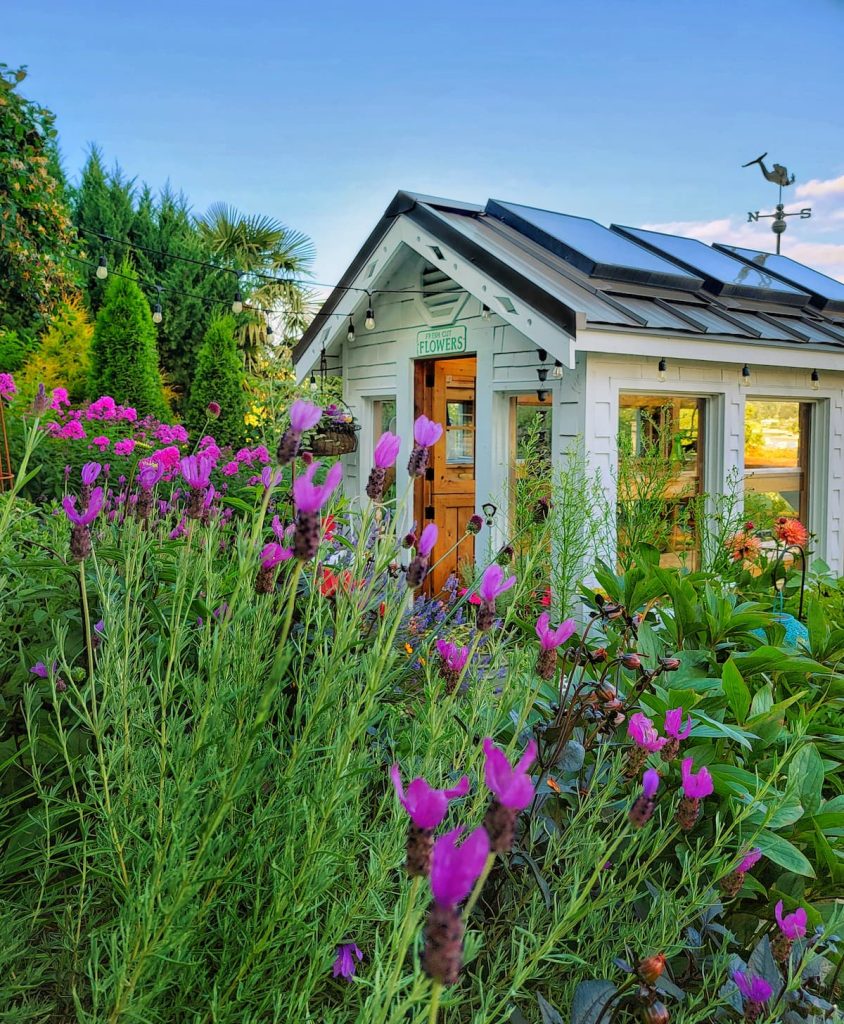
4. Lavender (Lavandula)
When you think of these fragrant and versatile herbs, relaxation and tranquility come to mind. Lavender is perfect for creating a serene and soothing vibe in your garden.
This traditional English cottage garden plant has a distinctive scent that acts as a natural repellent for pests like mosquitoes and flies but also attracts beneficial pollinators.
Lavender’s slender, silvery foliage contrasts with its vibrant blooms, which appear in purple, pink, and white shades. Plant lavender in rows, borders, or scattered throughout your cottage garden.
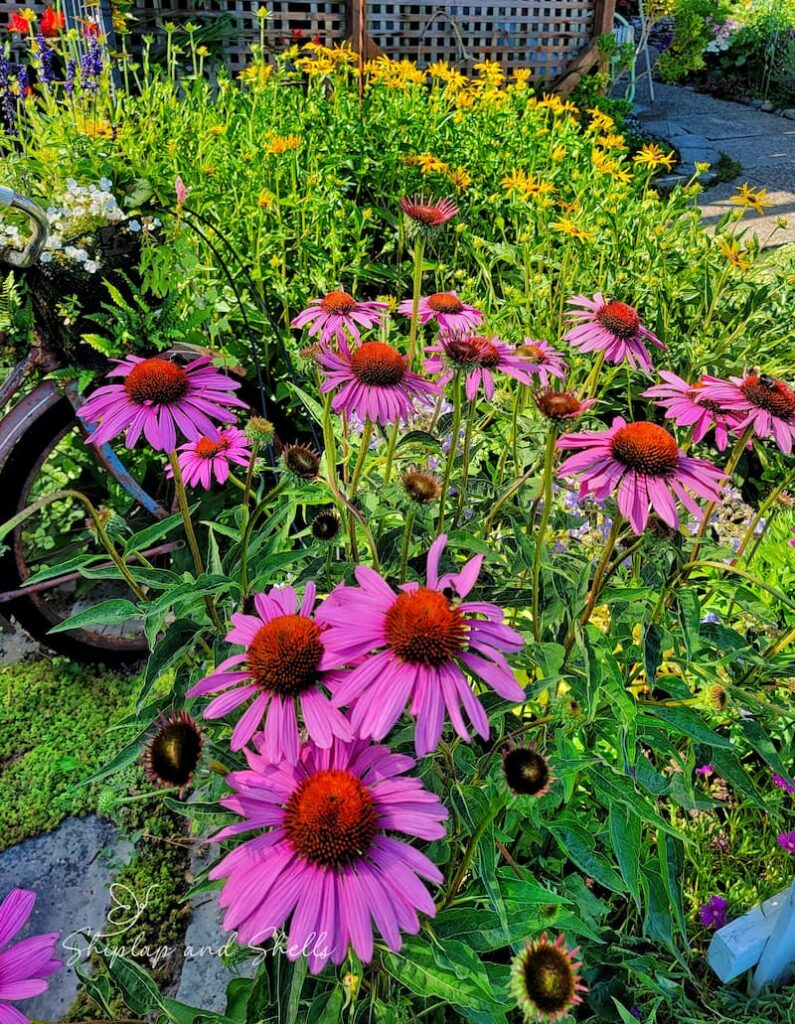
5. Coneflower (Echinacea)
These gorgeous perennials are a good choice for any cottage garden design. Coneflowers, or Echinacea, bring a brilliant burst of color and are perfect plants for attracting pollinators like butterflies, bees, and other beneficial insects.
They feature beautiful daisy-like flowers with cone-shaped centers and come in various shades, including pink, purple, white, and orange.
Coneflowers are low-maintenance plants that thrive in various soil conditions, making them ideal for cottage gardens. They have a long flowering season, providing continuous blooms from summer to fall, and their seed heads offer winter interest in the garden.
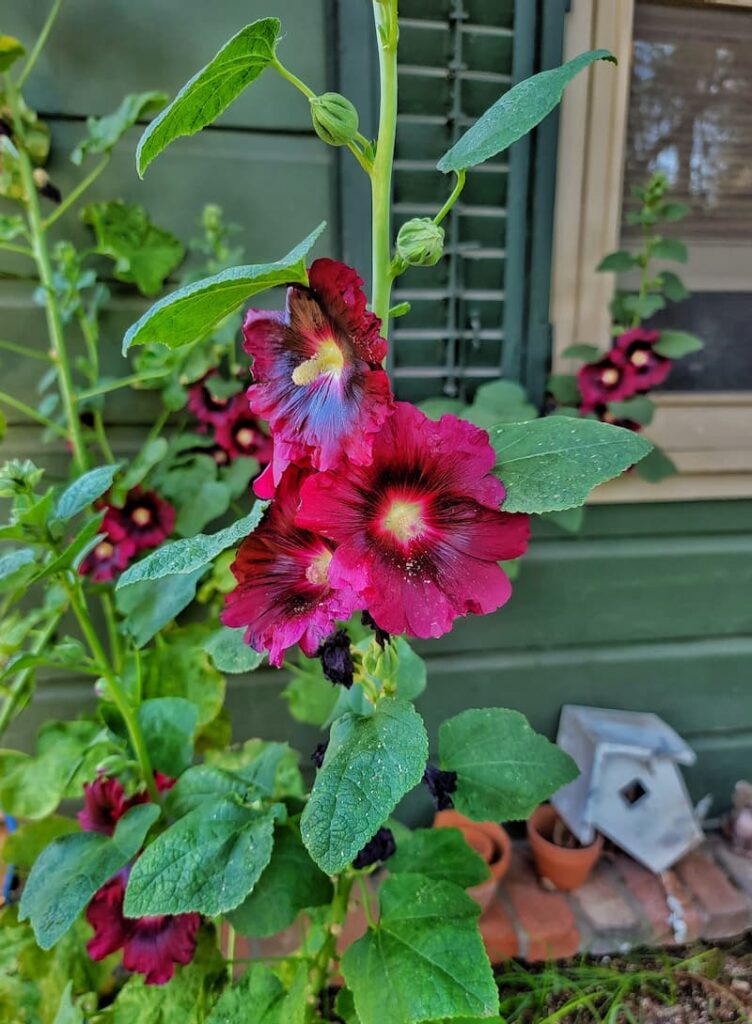
6. Hollyhocks (Alcea)
With their stunning, saucer-shaped flowers, hollyhocks are a favorite amongst gardeners for their ability to create a charming and nostalgic atmosphere.
These tall perennials add vertical interest to the garden, creating a sense of old-fashioned charm. They’re the perfect touch to a cottage garden, whether planted against a wall, along fences, or as a backdrop to lower-growing plants.
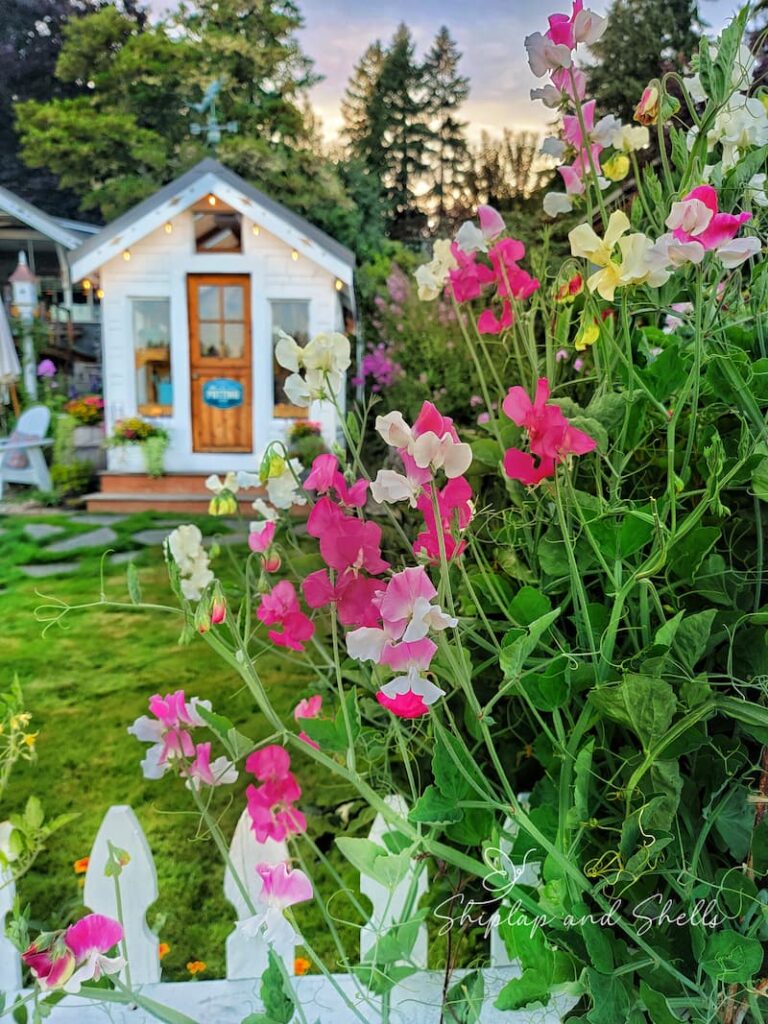
7. Sweet Peas (Lathyrus odoratus)
Sweet peas are a true favorite among traditional cottage garden plants. These delicate and fragrant climbers are known for their charming blooms and captivating scent.
Sweet peas are dainty flowers that appear in clusters and offer a wide range of colors, including soft pastels, vibrant pinks, and rich purples, allowing you to create a whimsical and romantic display in your garden.
Whether cascading along trellises, climbing over arches, or growing along fences, sweet peas bring an old-fashioned charm to the cottage garden.
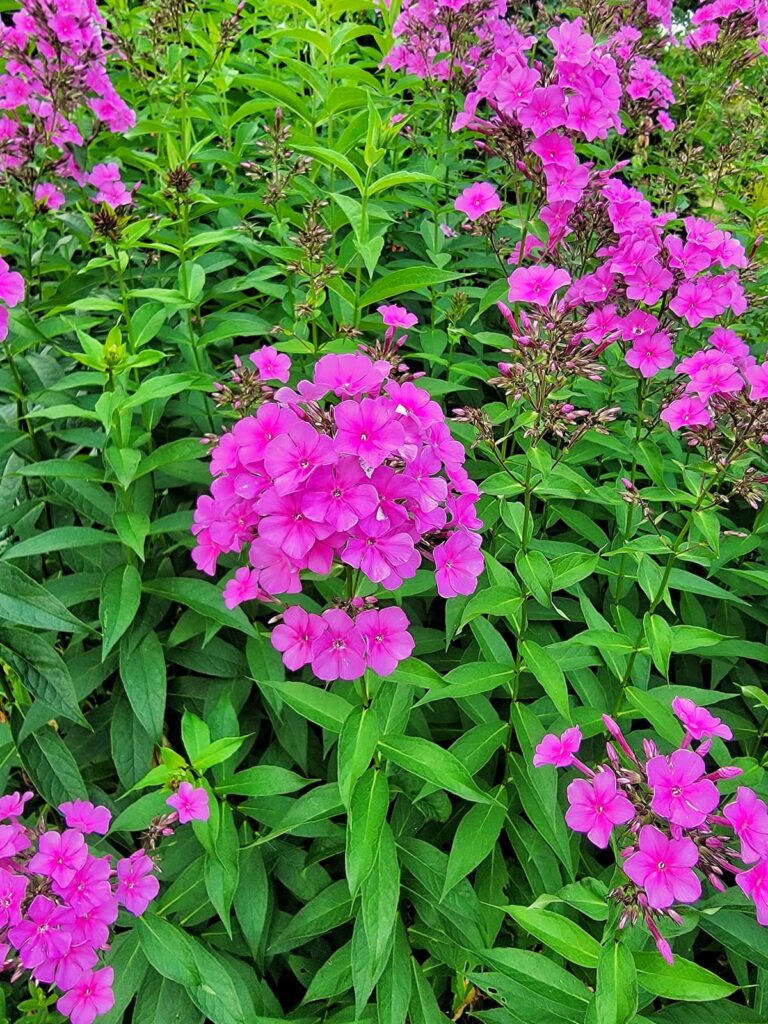
8. Phlox
With its stunning clusters of fragrant flowers, garden phlox is an exceptional choice for a cottage garden. These versatile perennials come in various shades, including pinks, purples, whites, and blues.
Phlox blooms create a charming and romantic feel of a traditional cottage garden. Their blooms are a favorite for pollinators like bees and butterflies.
Whether used as a backdrop or in mixed plantings, phlox flowers bring beauty and a classic touch to the cottage garden, making them a perfect choice for cottage-style plantings.
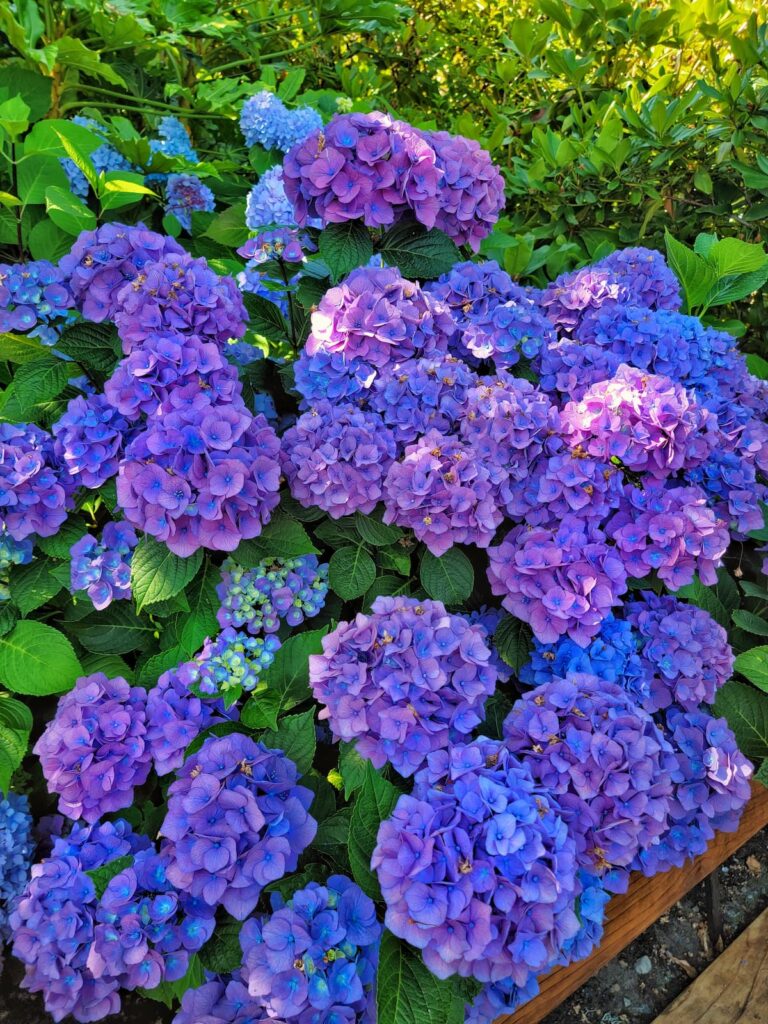
9. Hydrangeas
Hydrangeas are a perfect choice for a cottage garden, adding a touch of beauty and charm with their large and lush flower clusters. These versatile flowering shrubs are known for their stunning blooms, ranging in colors from vivid blues and purples to soft pinks and whites.
Hydrangea blooms provide long-lasting interest throughout the summer months and are known for adapting to different garden styles, whether a formal border or a more relaxed setting.
These perennial plants thrive in partial shade and are perfect for cottage gardens with dappled sunlight. Their stunning shrubs attract pollinators and butterflies.
Hydrangeas also make excellent cut flowers for floral arrangements and are easy to dry and use in your home decor.
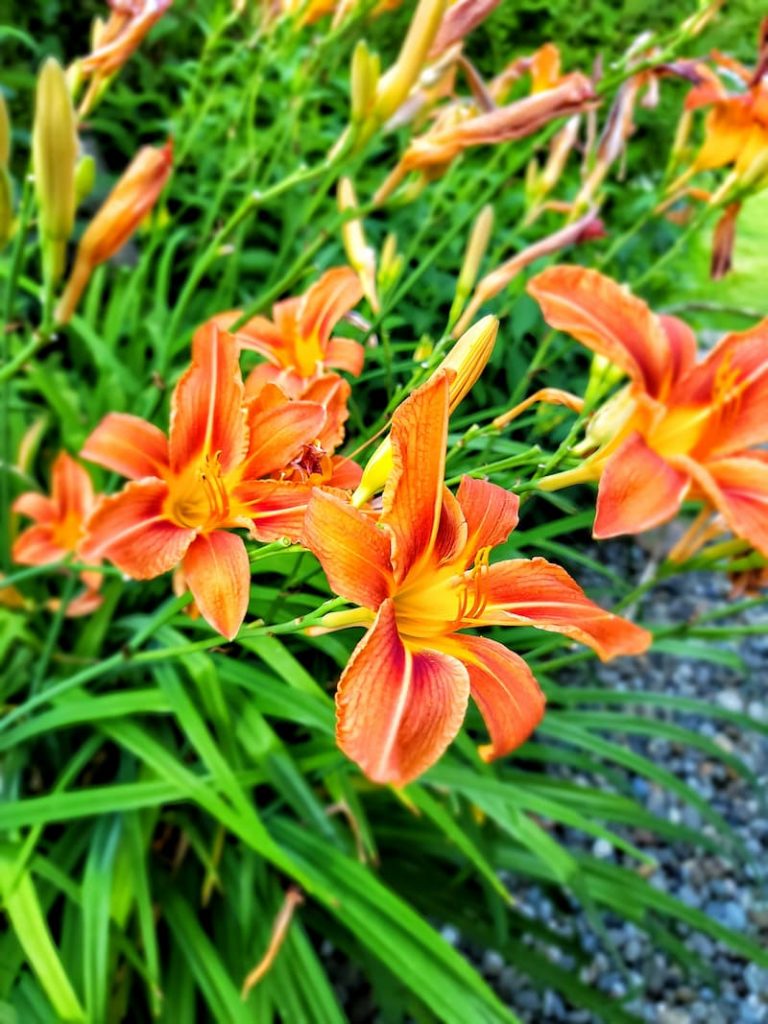
10. Daylilies (Hemerocallis)
This low-maintenance perennial comes in a wide range of colors, including vibrant oranges, yellows, pinks, and purples, adding a splash of color to the garden.
With their trumpet-shaped flowers and slender, arching foliage, daylilies’ extended blooms are a reliable choice for a cottage garden setting. Each flower lasts only a day, but the plant produces multiple buds to ensure continuous display throughout the season.
Daylilies thrive in various soil types and tolerate different light conditions, making them a strong option for different areas in the garden. They are also low-maintenance, making them ideal for busy gardeners.
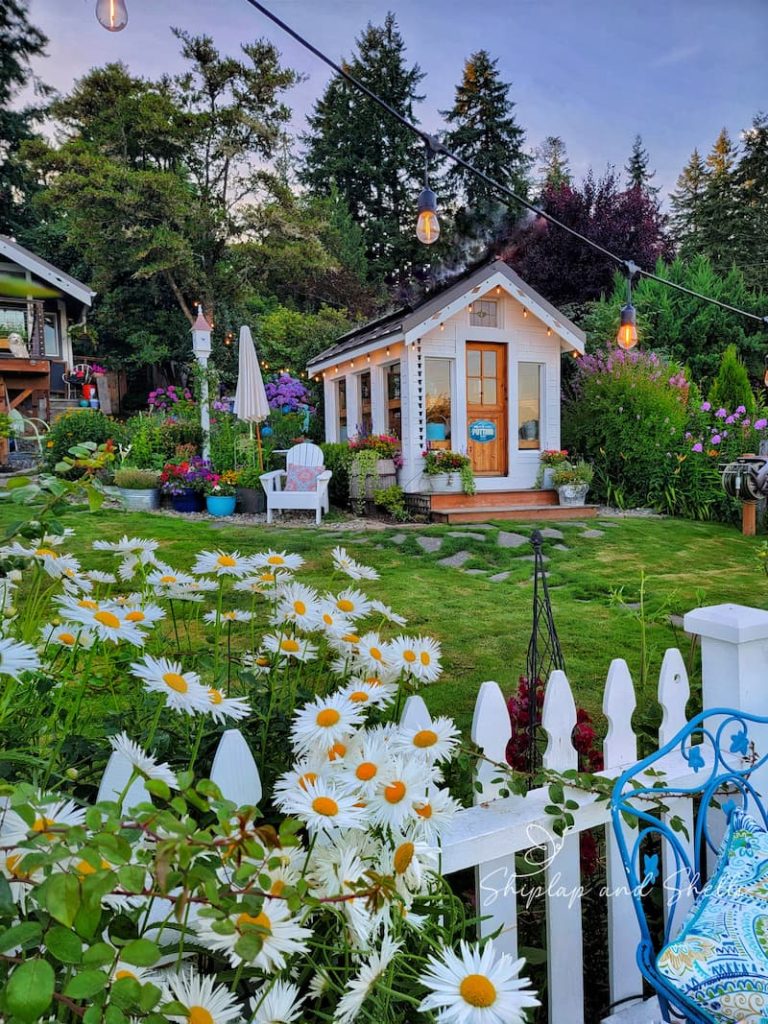
11. Daisies (Bellis perennis)
These cheerful blooms bring happiness and charm to the garden with their dainty petals and sunny yellow centers.
Daisies are incredibly versatile and can be used in various ways, from filling flower beds and borders to brightening flower containers.
These low-maintenance perennials can thrive in different soil conditions, making them an excellent choice for cottage gardeners at all skill levels.
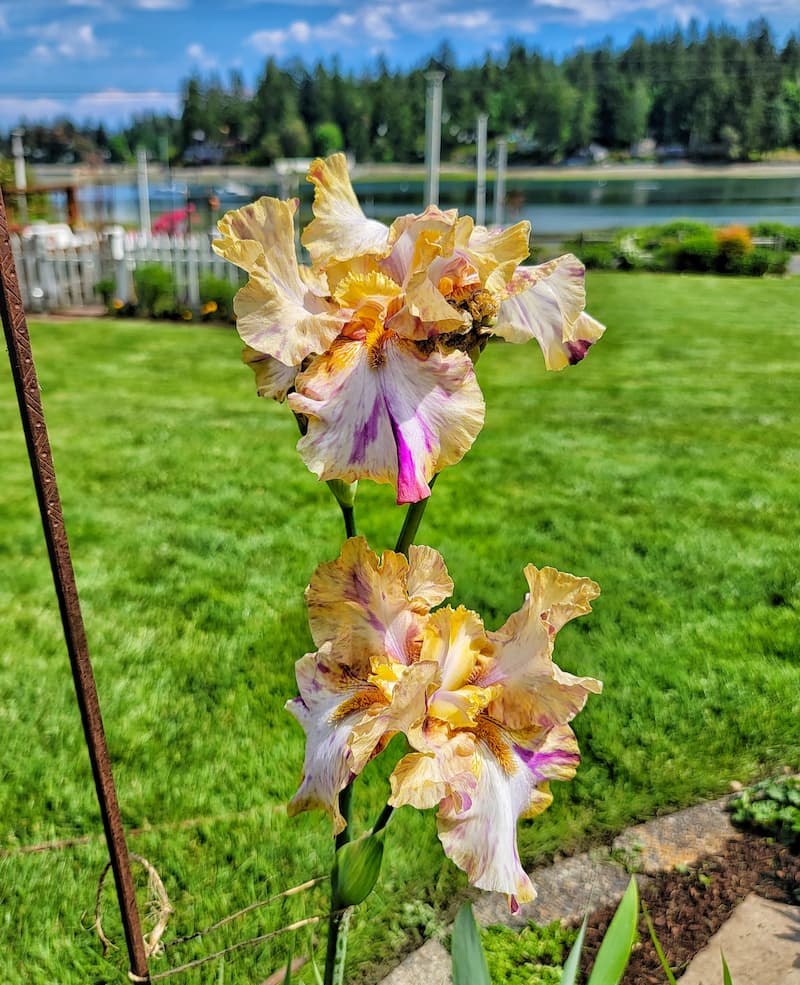
12. Irises
When choosing flowers for a cottage garden, irises are among the best choices. Their stunning and vibrant colors, ranging from deep purples and blues to soft pinks and yellows, make a stunning statement in cottage garden beds and borders.
Irises’ distinctive sword-like foliage adds visual interest even when the flowers are not blooming.
They’re also incredibly versatile. Different varieties bloom at various times, ensuring a prolonged flowering season. Their beautiful blooms will attract butterflies and hummingbirds to your garden.
Whether you choose tall bearded irises or Siberian Irises, these flowers will create a captivating cottage garden display that will leave a lasting impression on anyone who visits.

13. Cosmos
These charming flowers have a whimsical and carefree nature that perfectly complements the cottage garden style. They’re versatile and can be planted in masses or mixed with other cottage garden flowers.
Cosmos adds a touch of beauty and grace to any garden bed with its delicate and feathery foliage and wide range of colors, including shades of pink, white, and deep burgundy. Pollinators such as bees and butterflies love these annual flowers.
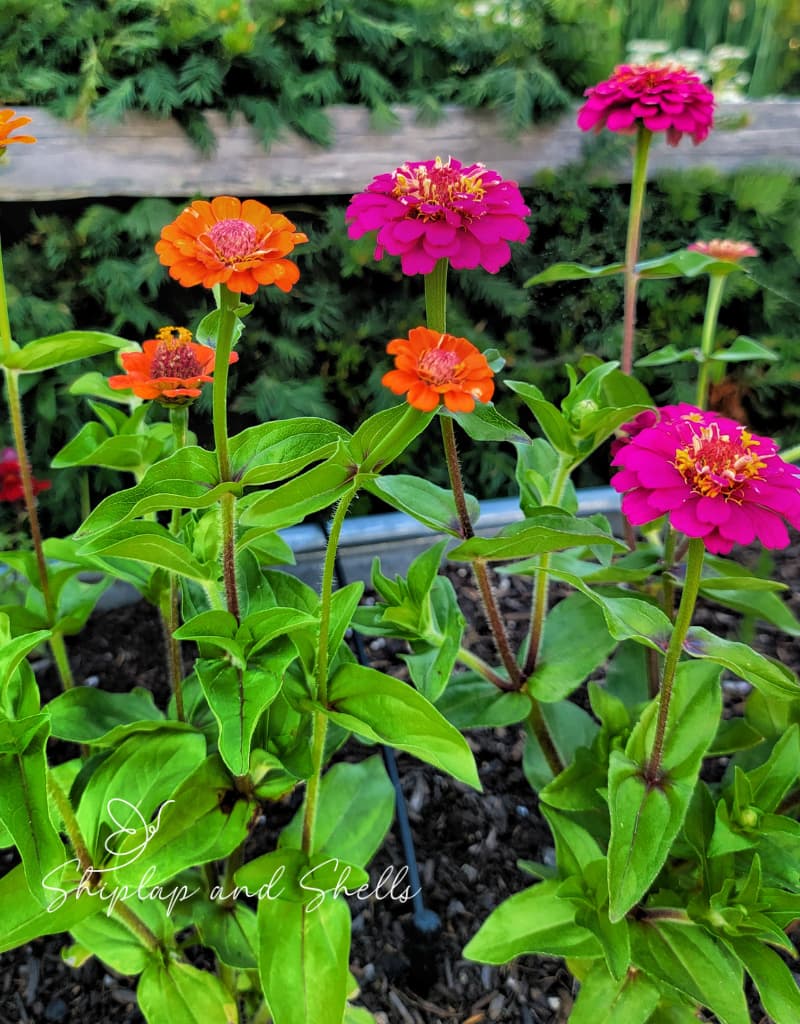
14. Zinnias
These beautiful blooms, which come in various colors, including bright oranges, pinks, yellows, greens, and purples, add cheerful views to your garden beds.
Zinnias are known for their long-lasting flowers, continuously displaying beauty throughout the summer. Their tall stems make them an excellent choice for creating stunning cut flower arrangements, bringing the garden’s beauty indoors.
These summer annuals are easy to grow from seeds and are incredibly resilient. They thrive in full sun and tolerate various soil conditions. The more you harvest and deadhead zinnias, the more flowers you produce throughout the season.
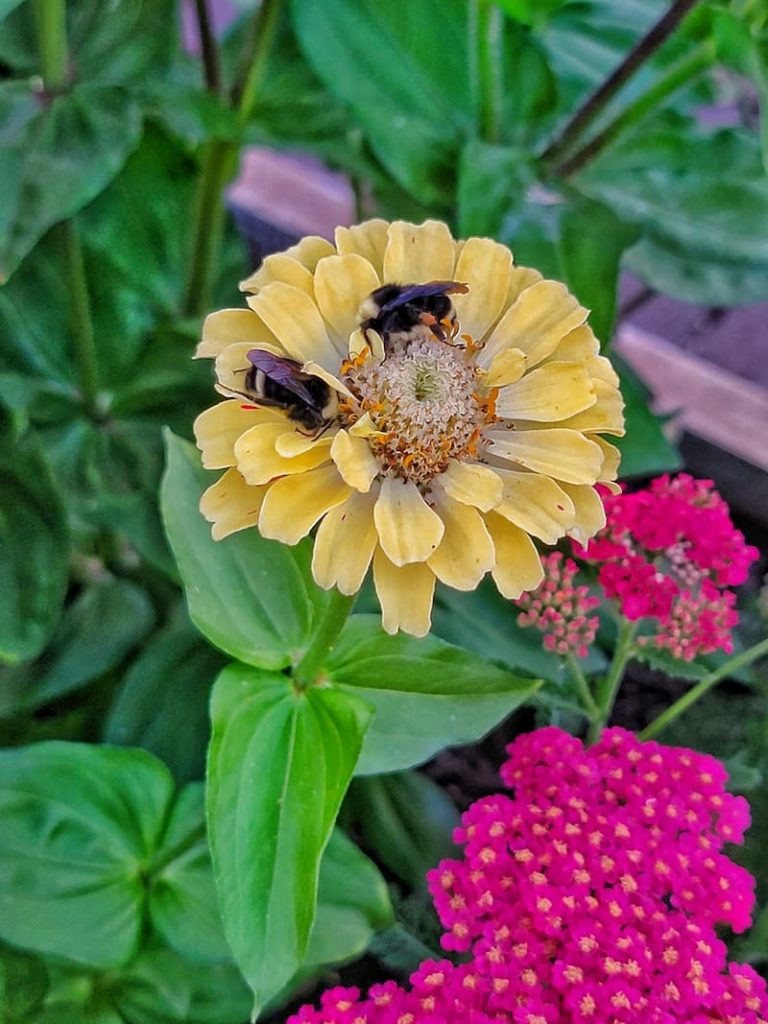
My favorite thing about growing zinnas in the cottage garden is watching the bees sleep in the flower heads each evening. I can walk out at any given time and see almost every zinnia hosting a bee for the night. It’s fascinating!
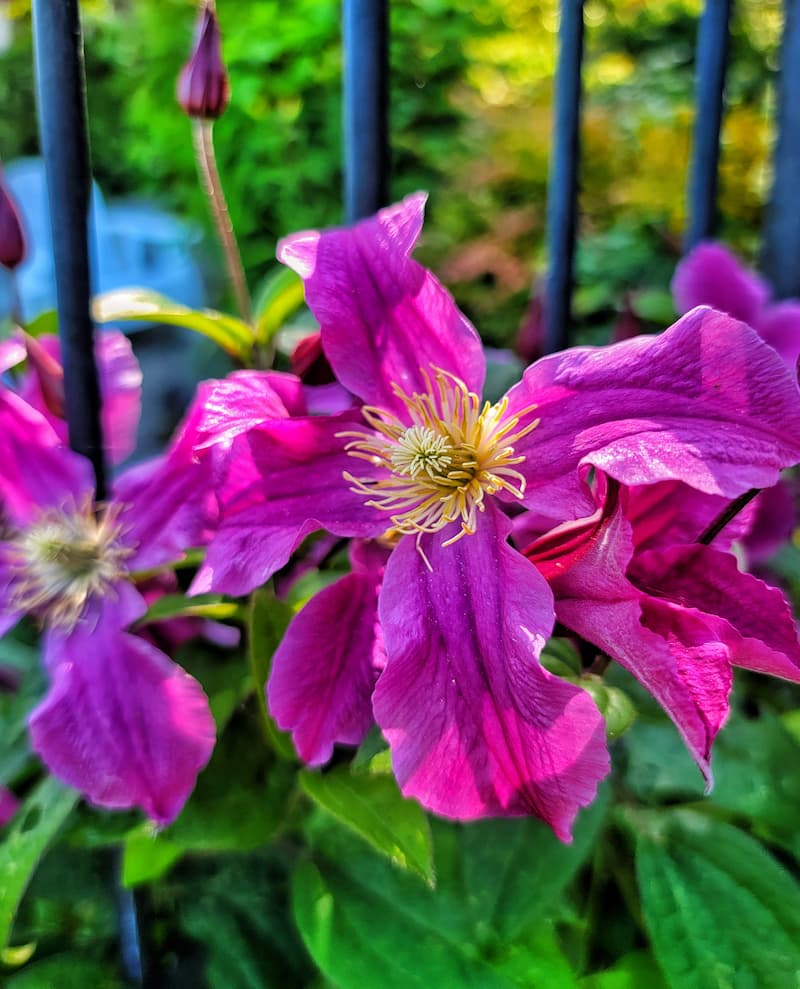
15. Clematis
Known for its show-stopping blooms and vigorous climbing nature, clematis vines add vertical interest and a touch of elegance to any garden space.
With various colors, from vibrant purples and blues to soft pinks and whites, clematis offers endless possibilities for creating stunning focal points on trellises, arbors, or fences. With proper care and pruning, clematis can thrive for many years.
Whether you choose a compact variety for container gardening or a vigorous climber for vertical displays, clematis is undoubtedly one of the best flowers to grow for an enchanting cottage garden.
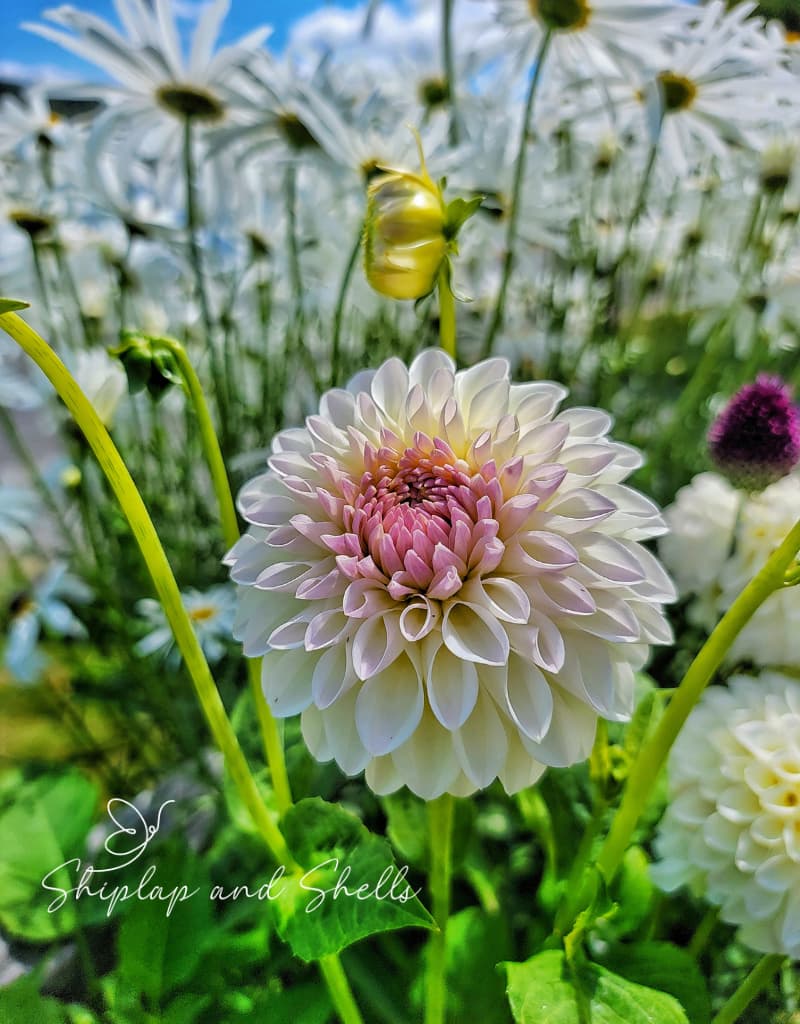
16. Dahlias
With their stunning and diverse range of colors, shapes, and sizes, dahlias bring abundant beauty and charm to any garden space. These gorgeous perennial flowers can be found in almost any color, including red, pink, yellow, orange, and even exotic bi-color combinations.
From the dinner plate-sized varieties to the smaller pom-pom or cactus-shaped ones, dahlias offer many options to suit every gardener’s personal taste. Their long-lasting blooms make them perfect for cut flower arrangements.
Dahlias are relatively easy to grow and care for, making them a wonderful choice for cottage gardengardners of all skill levels. Whether you plant them in flower beds, borders, or containers, dahlias will surely become a stunning focal point in your cottage garden, even attracting butterflies and bees.
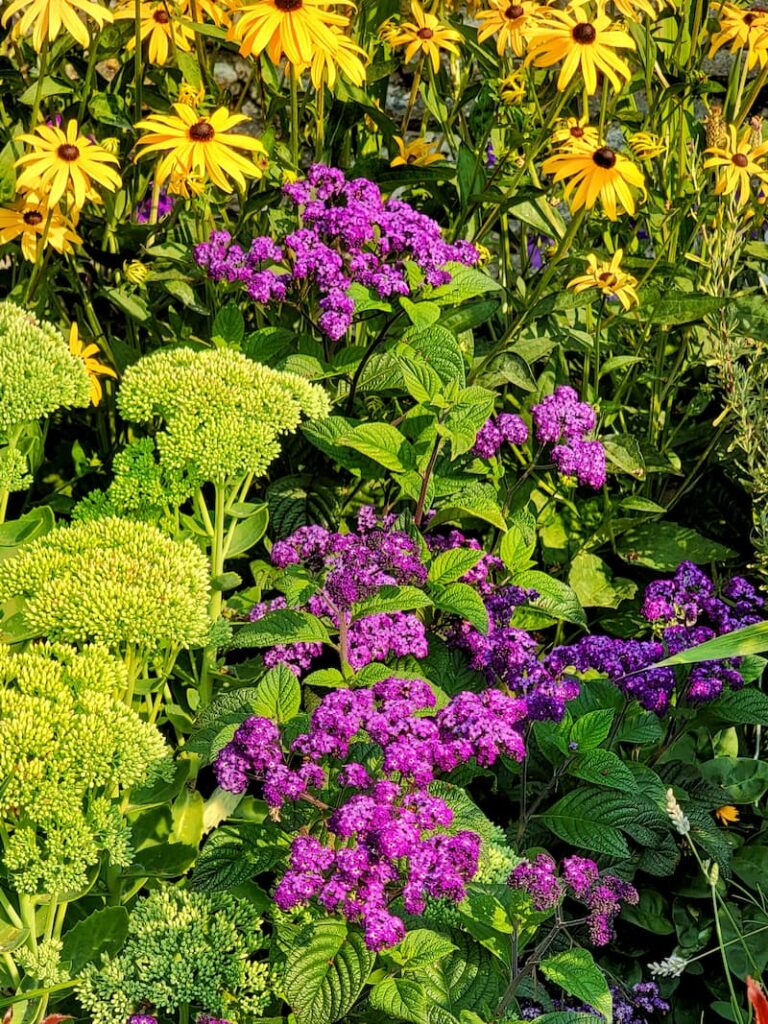
17. Heliotrope (Heliotropium)
Known for their rich, vanilla-scented flowers, which range from dark purple to lavender and sometimes white, heliotropes thrive in full sun, making them ideal for brightening up sunny borders.
Their rounded clusters of tiny, star-shaped flowers add a unique texture to the visual depth of cottage garden arrangements and attract bees and butterflies to your cottage garden.
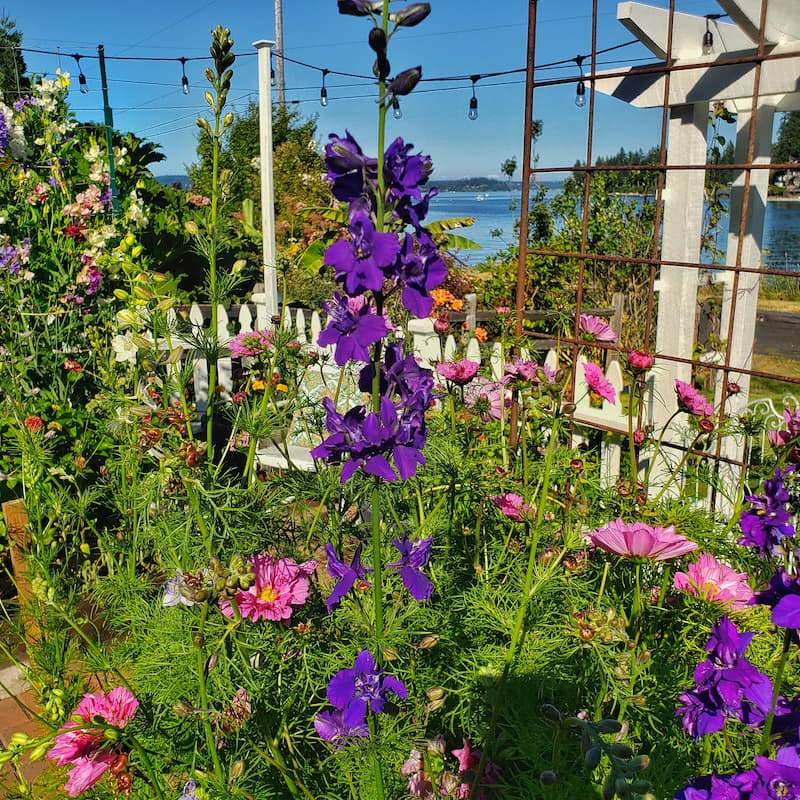
18. Larkspur
With their towering, vibrant blooms, larkspurs add height and dimension to your cottage garden layout. They come in shades of blue, purple, pink, and white.
These annuals attract pollinators like bees and butterflies and are relatively easy to grow from seed. Larkspur can adapt to various soil conditions but is best in cooler climates.
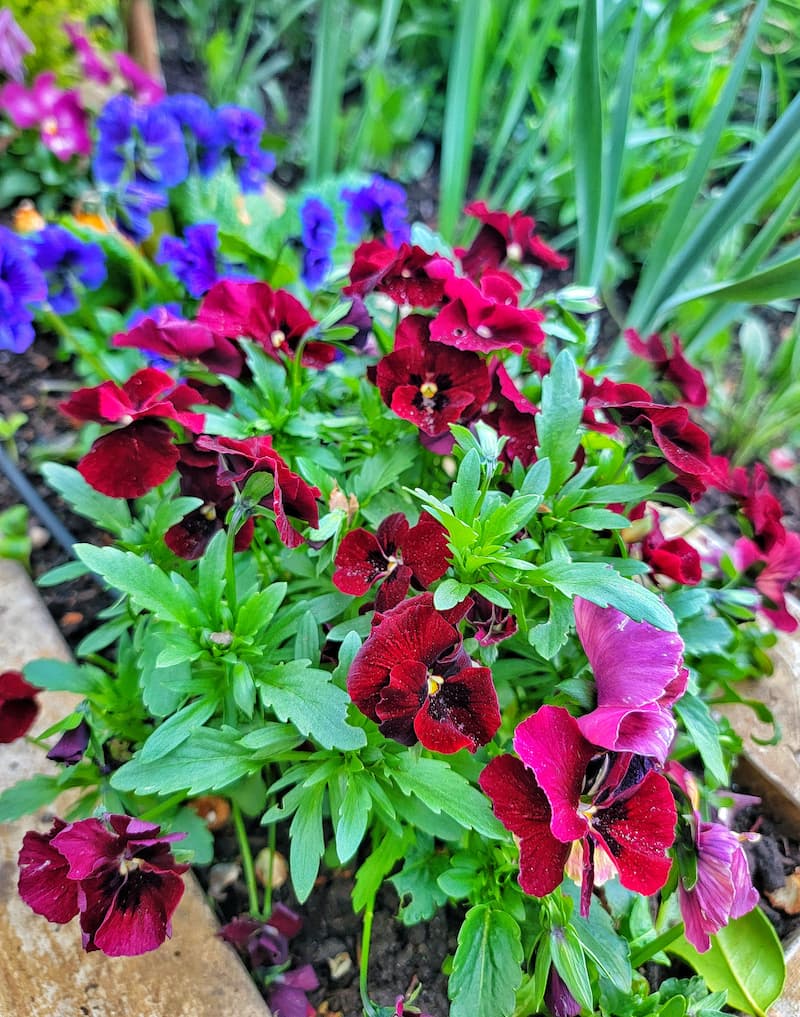
19. Pansies (Violas)
Pansies are a lovely choice for the cottage garden, bringing a cheerful splash of color and charm to any outdoor space. These hardy little flowers come in vibrant colors and patterns, ranging from bright yellows and oranges to deep purples and blues.
Pansies are incredibly versatile and can thrive in both spring and fall, making them ideal for extending the blooming season of your garden. Their ability to flourish in cooler temperatures means they can brighten up your garden when many other plants have yet to start in early spring or have finished blooming already.
These sweet flowers are low-growing and make excellent borders or edging plants. They can also be planted in containers to decorate patios, steps, and window boxes, adding a quaint, cottage-style coziness to any space.
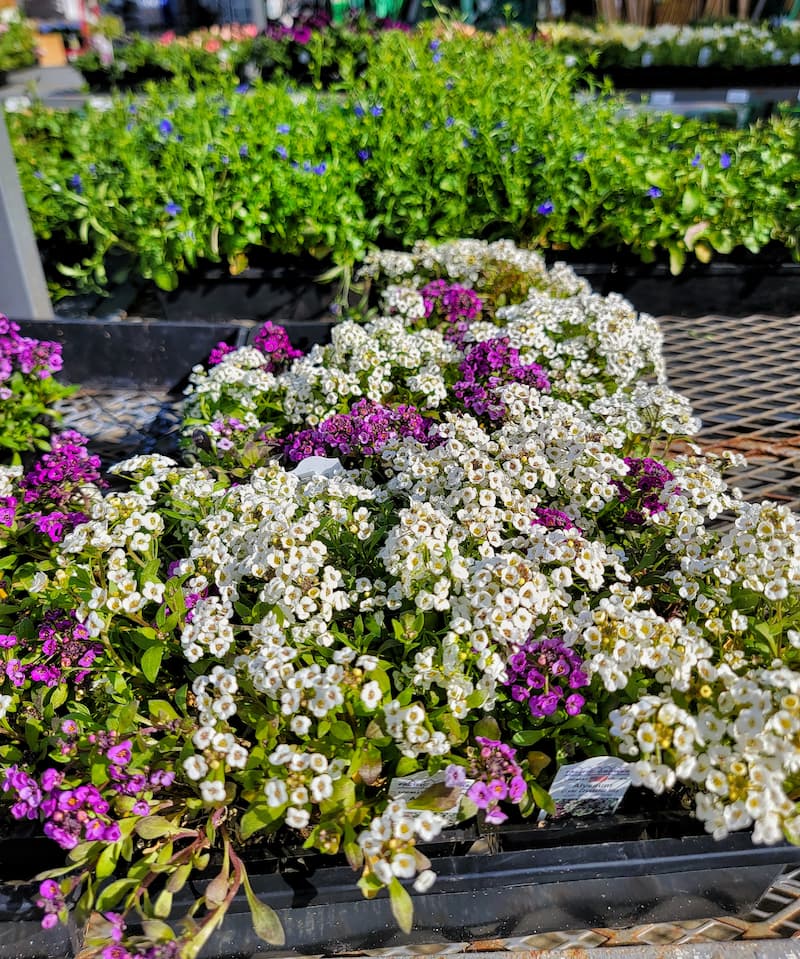
20. Sweet Alyssum (Lobularia)
Sweet Alyssum is a wonderful addition to the cottage garden, with its delicate honey-scented flowers and low-growing, ground-covering tradition.
This charming plant produces tiny clusters of blooms in shades of white, pink, and purple, creating a soft, carpet-like appearance that adds a beautiful visual and is practical for filling in gaps or softening edges.
Sweet Alyssum is incredibly easy to grow and care for, thriving in full sun to partial shade and blooming profusely from spring until frost. Its dense floral spread helps suppress weeds and maintain soil moisture.
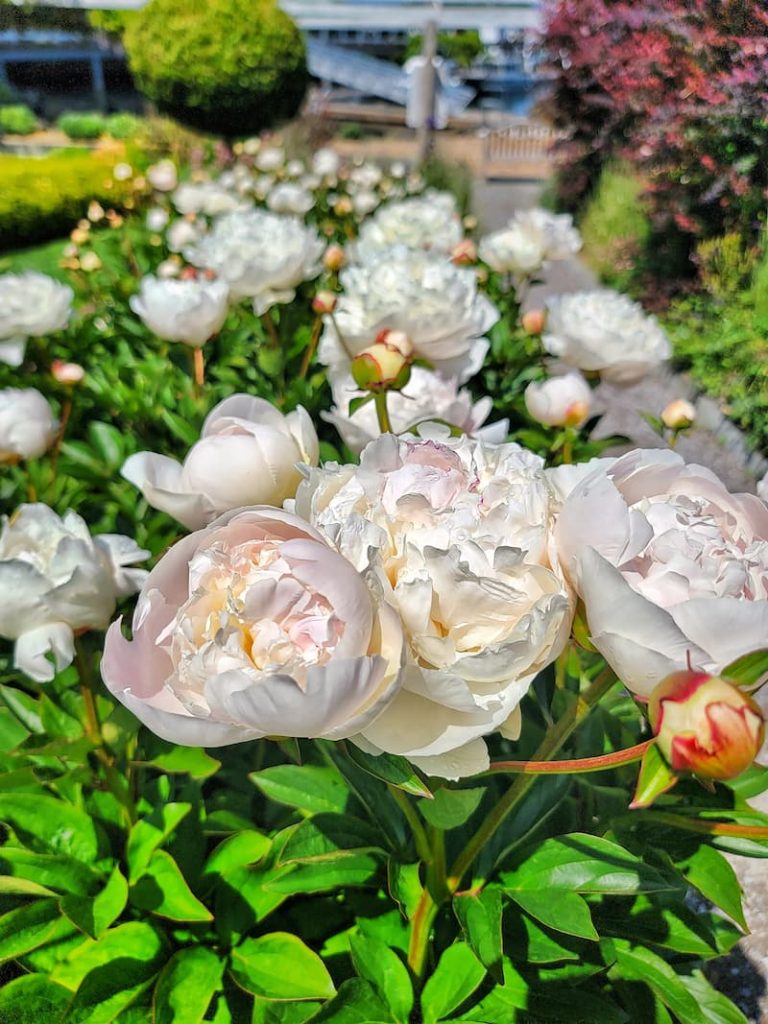
21. Peonies (Paeonia)
Peonies come in various colors, from pure white and soft pinks to rich reds and deep maroons. Their lush, full flowers make a dramatic statement when in bloom during late spring to early summer.
These perennial favorites are remarkably long-lived, capable of thriving in the same spot for decades with little care. Once established, peonies are drought-tolerant and resist deer and rabbits.
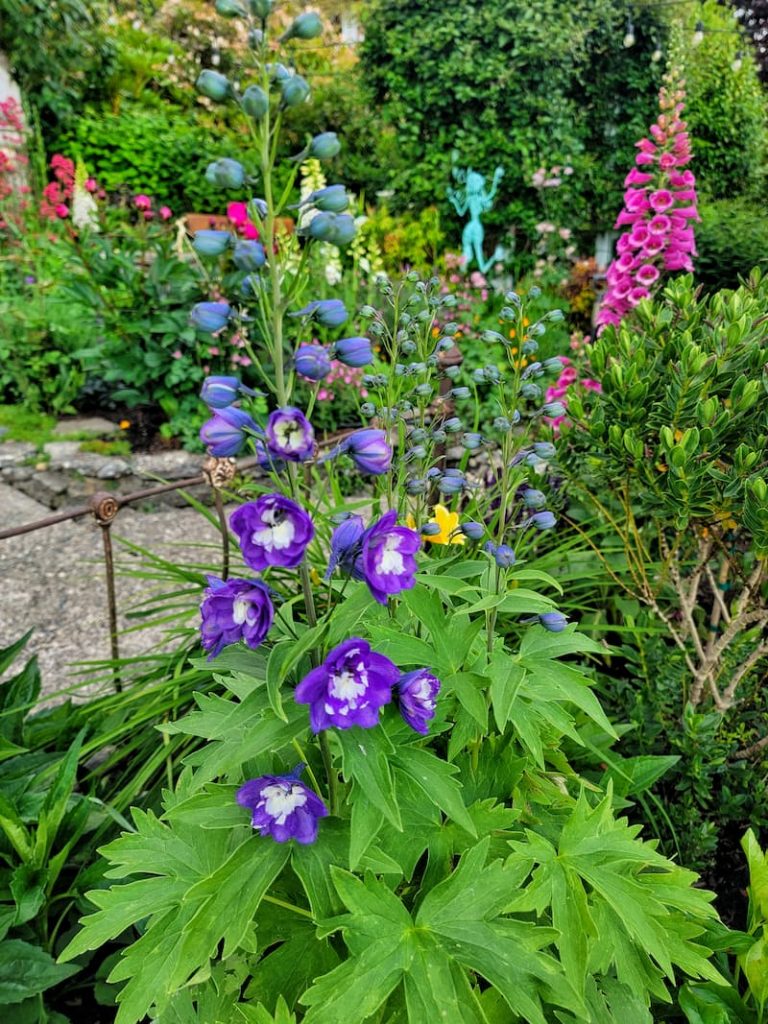
22. Delphinium
Delphiniums are a standout choice for any cottage garden. Their tall, majestic spikes of colorful flowers offer an exceptional vertical accent.
These stunning perennials bloom in white, pink, purple, and blue flowers. Delphiniums’ striking height, which can reach several feet, makes them ideal background plants, adding depth and structure to garden borders.
They flourish in cooler climates and prefer well-drained soil and full sun to partial shade, making them well-suited for many garden settings.
Delphiniums also attract pollinators like bees and butterflies, and their blooms are perfect for cutting and creating dramatic indoor floral arrangements.
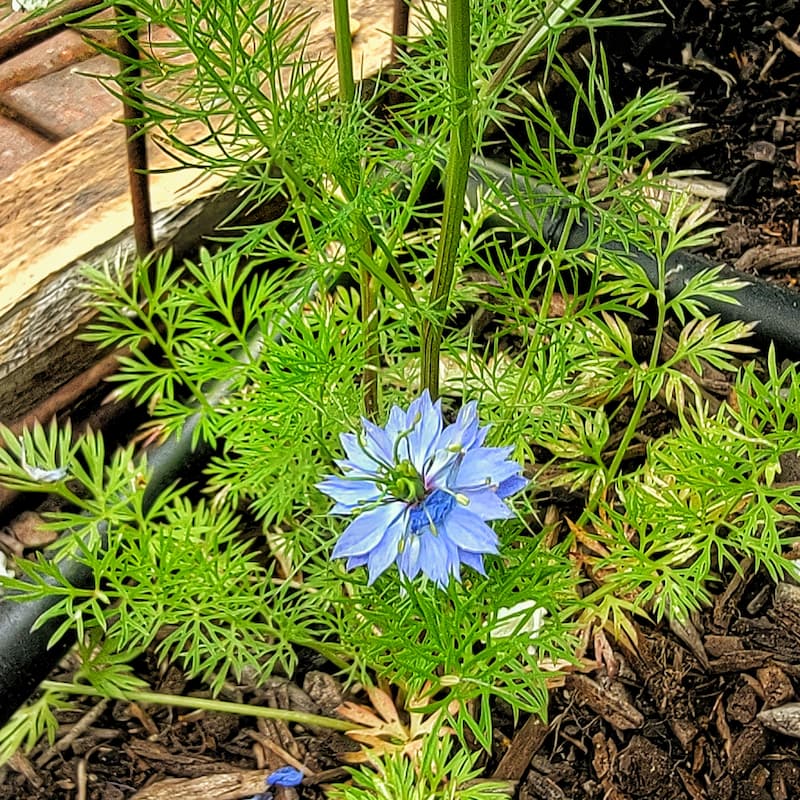
23. Love in a Mist (Nigella)
“Love in a Mist” has delicate flowers and misty foliage, which is why the plant gets its name. The flowers, which appear in shades of blue, white, pink, and purple, are nestled among a lacy collar of thread-like green leaves, creating a soft, almost whimsical appearance.
This annual plant is valued for its ease of growing and self-sowing tendency. It ensures a continual presence in the cottage garden year after year with little effort.
Blooming in late spring to early summer, “Love in a Mist” is ideal for filling gaps in the garden with bursts of color and texture. The seed pods that follow the flowers are ornamental, adding interest to the garden even after the blooming period.
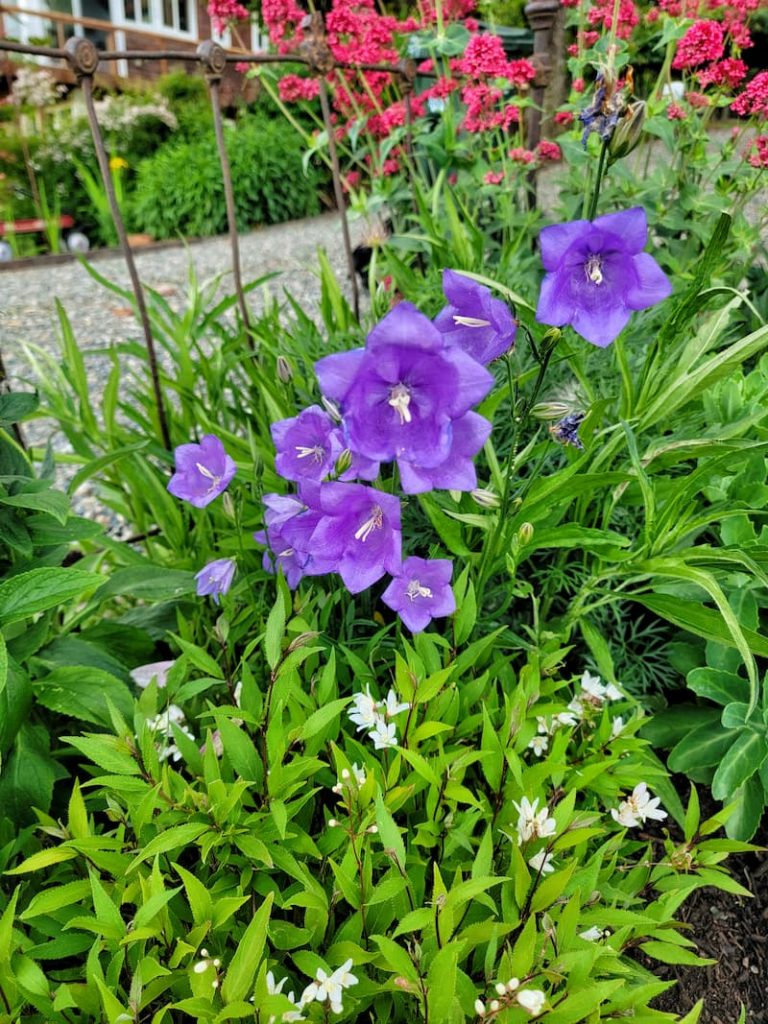
24. Campanula
Campanula, commonly known as bellflower, has unique bell-shaped blooms that fill the cottage garden with blue, purple, white, and pink hues, attracting pollinators such as bees and butterflies.
These plants range from low-growing varieties, which create lovely ground covers, to taller varieties. They’re versatile and hardy, thriving in various conditions from full sun to partial shade and preferring well-drained soils.
Their long flowering period, often from early summer to late summer, provides continuous color and life in the cottage garden. The charming heads of the bellflowers attract pollinators like bees and butterflies.
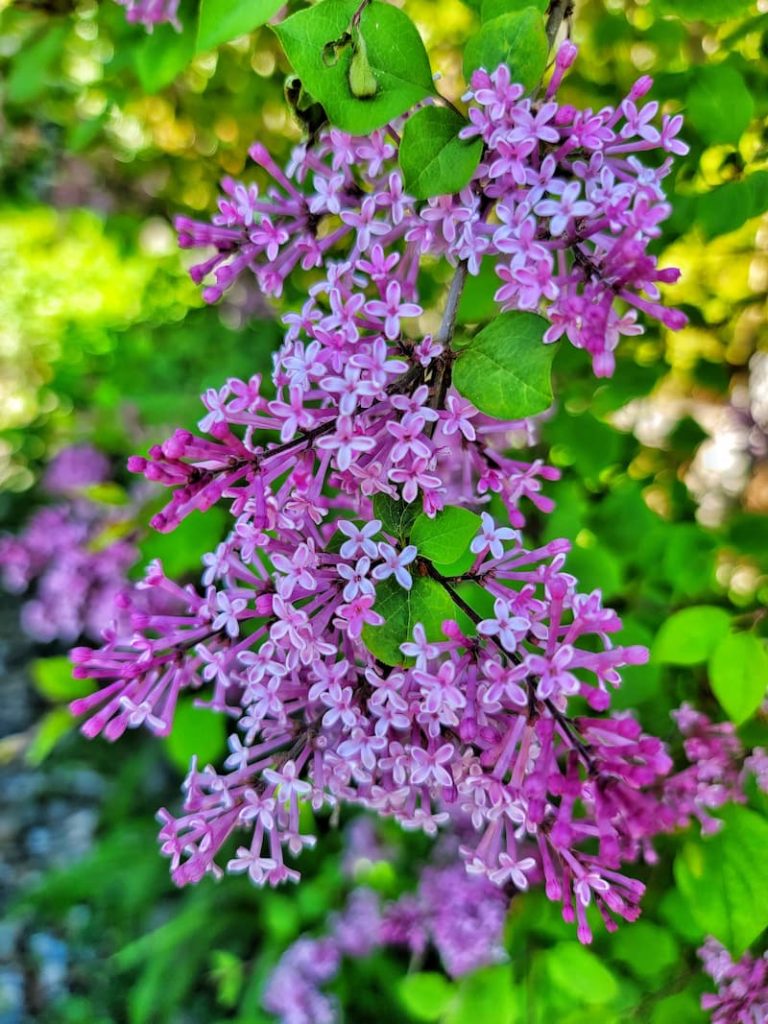
25. Lilacs (Syringa)
Lilacs are an iconic choice for a traditional cottage garden. Their hardy shrubs bloom profusely in shades of violet, lavender, white, and even pink, filling the air with their sweet perfume.
These perennials are often grown as hedge plants because they can provide structural height and a sense of privacy. Their dense clusters of blooms add a burst of early color, energizing the garden after the winter months.
Lilacs are easy to grow and require minimal maintenance beyond occasional pruning for shape. They thrive in well-drained soil and full sun.
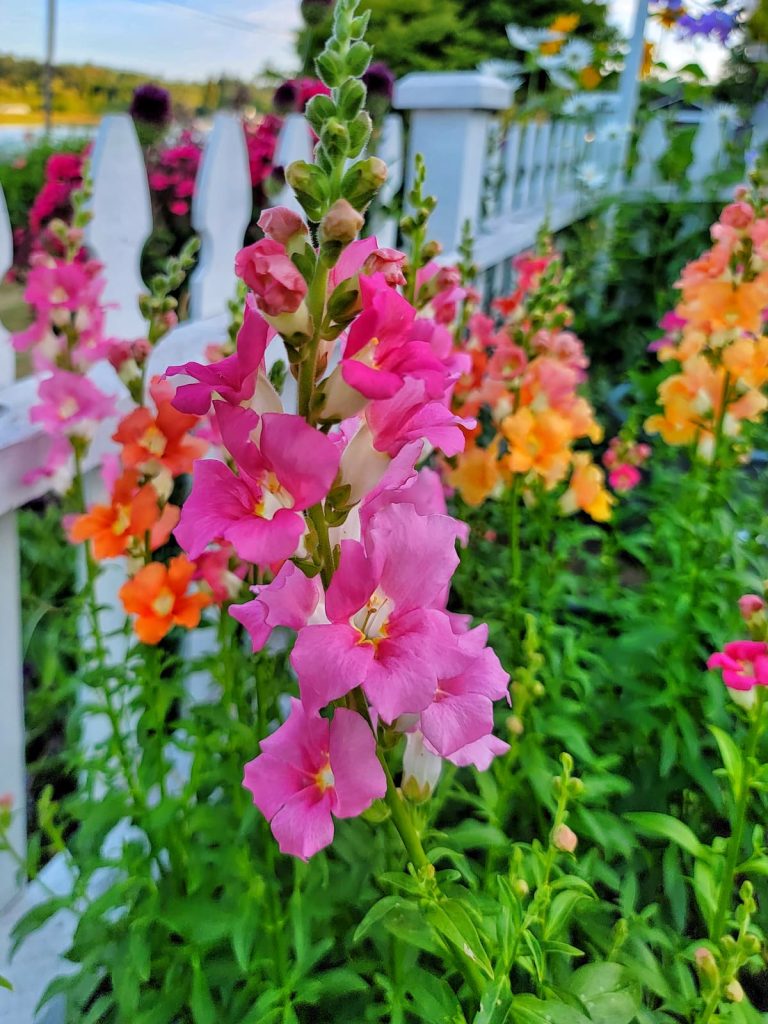
26. Snapdragons (Antirrhinum)
Snapdragons are a vibrant addition to a charming cottage garden. Their distinctive, dragon-shaped flowers open and close when gently squeezed.
From soft pastels to bright, bold hues, snapdragons can complement any garden palette and add vertical interest with their tall, spiky blooms.
Thriving in cooler climates and blooming profusely from spring through fall with proper deadheading, snapdragons are excellent for adding height to flower beds. Their tiered growth habit makes them ideal for background plantings or mixed borders.
They attract beneficial pollinators like bees and butterflies and adapt to various soil conditions, making them a practical choice for novice and experienced gardeners alike.
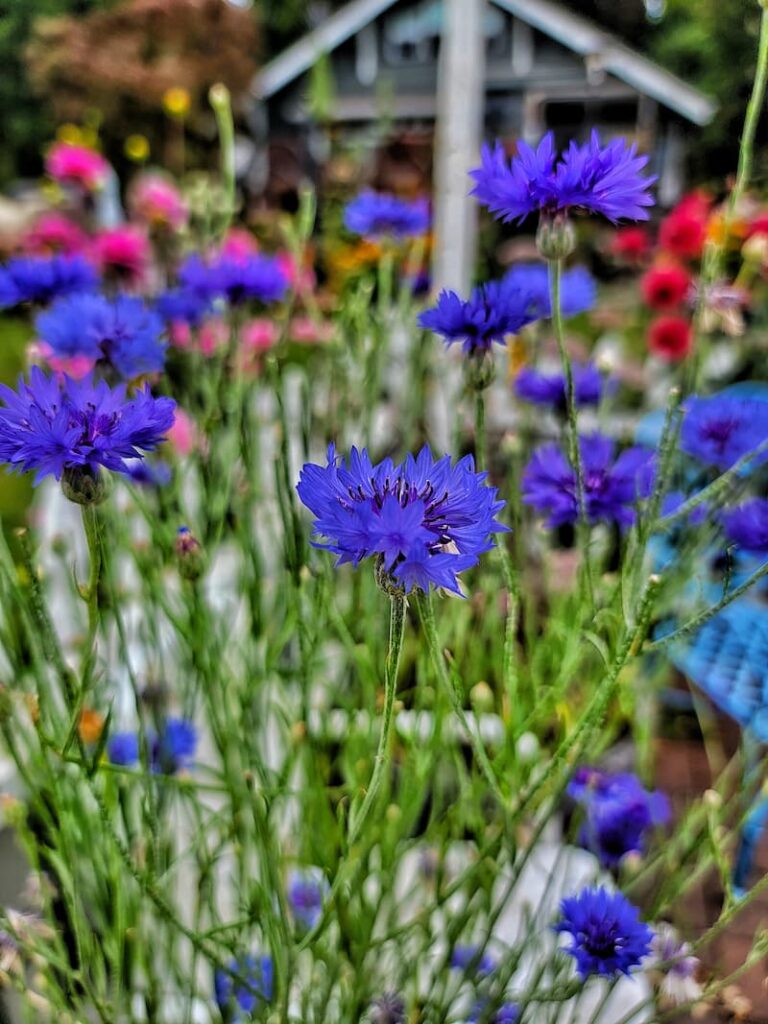
27. Bachelor’s Button (Centaurea cyanus)
Bachelor’s button, also known as cornflower, has bright, cheerful blooms in vivid shades of blue, pink, white, and purple.
Their hardy nature and ease of care, thriving in poor soils and resisting drought, make them a low-maintenance choice for gardeners looking to add long-lasting color with minimal fuss.
Bachelor Button plants’ ability to self-seed ensures they return to the cottage garden year after year. The flowers attract bees and butterflies, contributing to the pollination of your garden, and their tall, slender stems make them ideal for cutting and creating rustic bouquets.
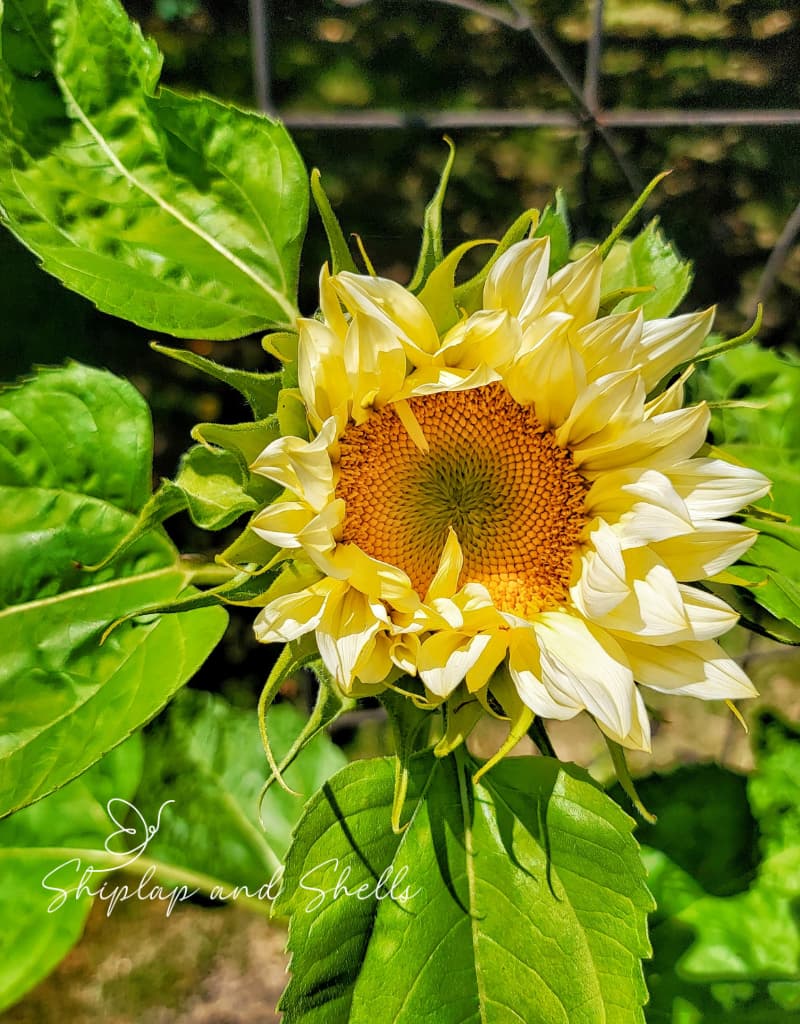
28. Sunflowers (Helianthus annuus)
Sunflowers have towering blooms of various sizes and colors, ranging from classic bright yellow to rustic reds and even multi-colored varieties.
These cottage garden perennial plants are incredibly easy to grow, thriving in well-drained soil and full sun. Their rapid growth and towering height make them perfect as a natural privacy screen or a dramatic backdrop for lower-growing plants in the garden.
Sunflower seeds attract birds towards the end of the season, while their nectar and pollen are favorites among bees and butterflies.
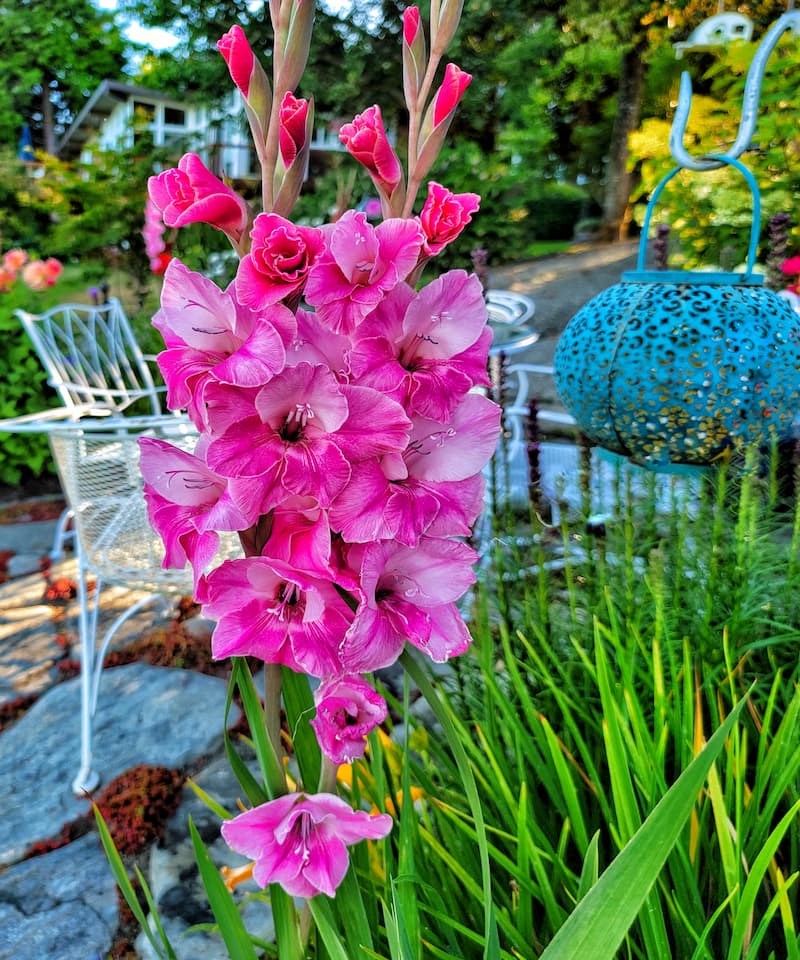
29. Gladiolus
Gladiolus are known for their dramatic spikes of trumpet-shaped flowers in spectacular colors, ranging from soft pastels to vivid, intense shades. They add height and structure to floral arrangements in the garden and when cut for indoor display.
These perennials bloom in a succession from the bottom of the spike upwards, extending the display of vibrant colors from mid-summer into late fall.
Gladiolus thrive in sunny spots with well-drained soil and are easy to plant and grow. The corms can be planted in stages for a continuous bloom.
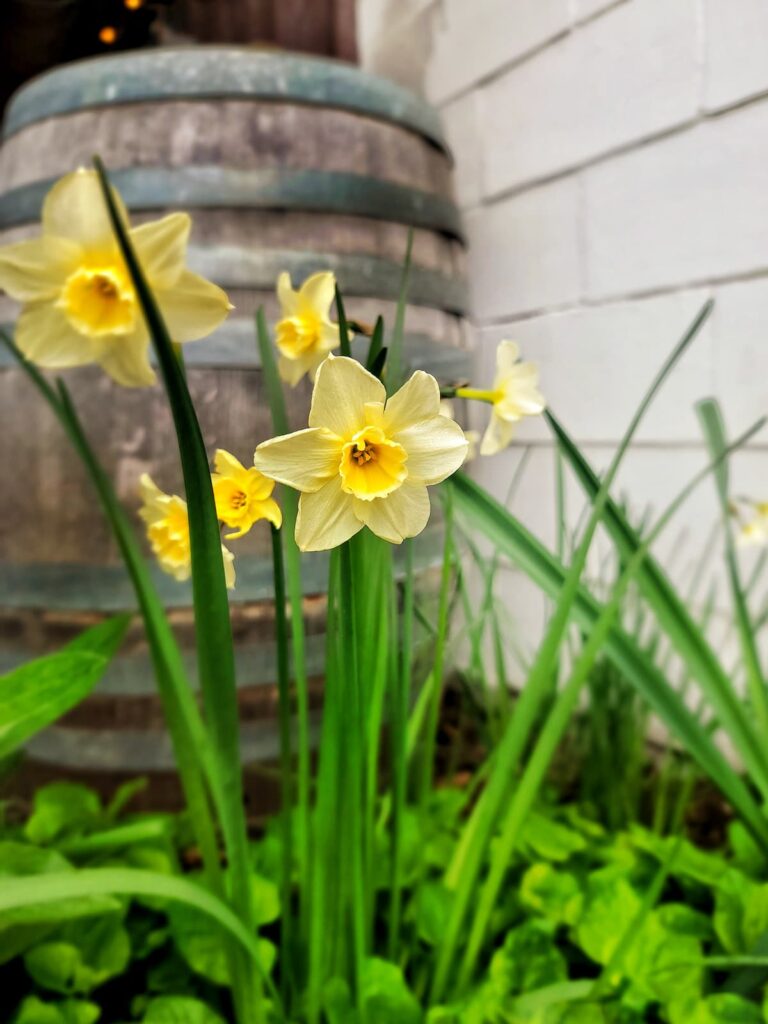
30. Daffodils (Narcissus)
Daffodils are a great plant choice for the spring cottage garden, symbolizing the rejuvenation of spring with their bright, cheerful blooms.
These hardy perennials are among the first to bloom each year, offering a burst of color when most of the garden is still waking from winter.
Daffodil flowers are incredibly easy to grow, requiring minimal care once planted. They naturalize beautifully, meaning they multiply and return more plentifully each year.
Their iconic trumpet-shaped flowers come in shades of yellow, white, and orange and are resistant to pests and deer, making them a must-have for any low-maintenance gardener.
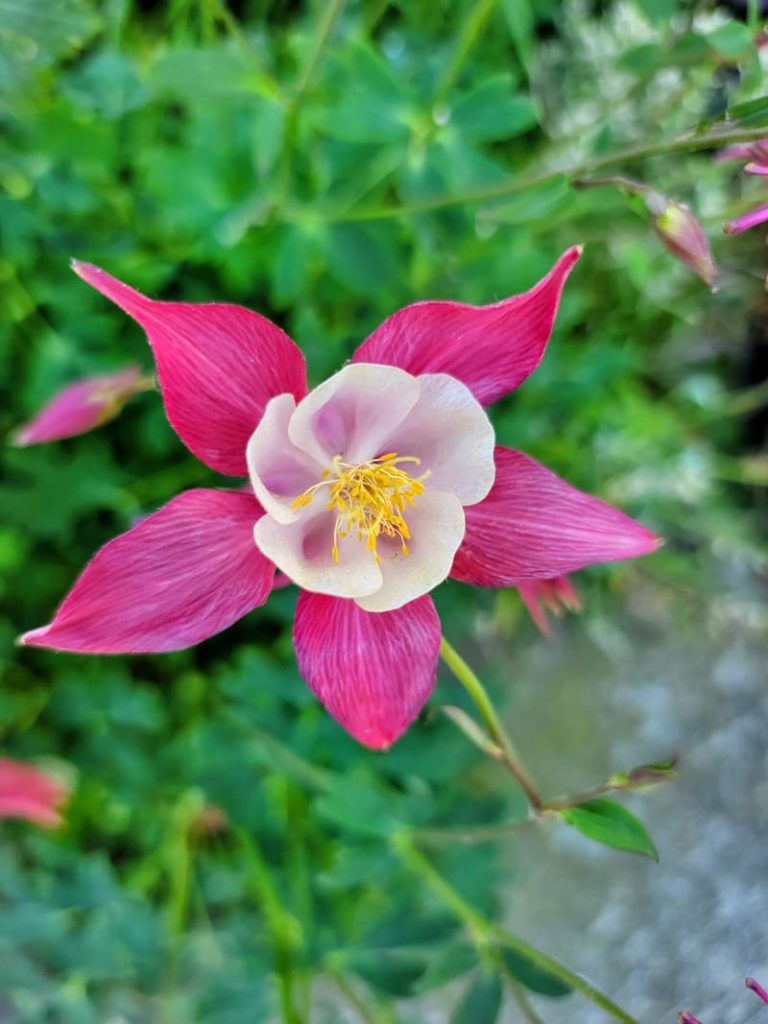
31. Columbine (Aquilegia)
Columbine is an excellent addition to the cottage garden with its distinctive, graceful flowers. These perennial blooms are uniquely shaped with spurred petals and are available in various colors, including blues, purples, pinks, reds, and whites.
Columbine thrives in partial shade or full sun. Its ability to self-seed and spread guarantees year after year flowers. They attract pollinators, including hummingbirds and butterflies, adding life to the garden.
Their mid-spring to early summer blooming period also helps bridge the gap between early spring bulbs and peak summer blooms in the cottage garden.
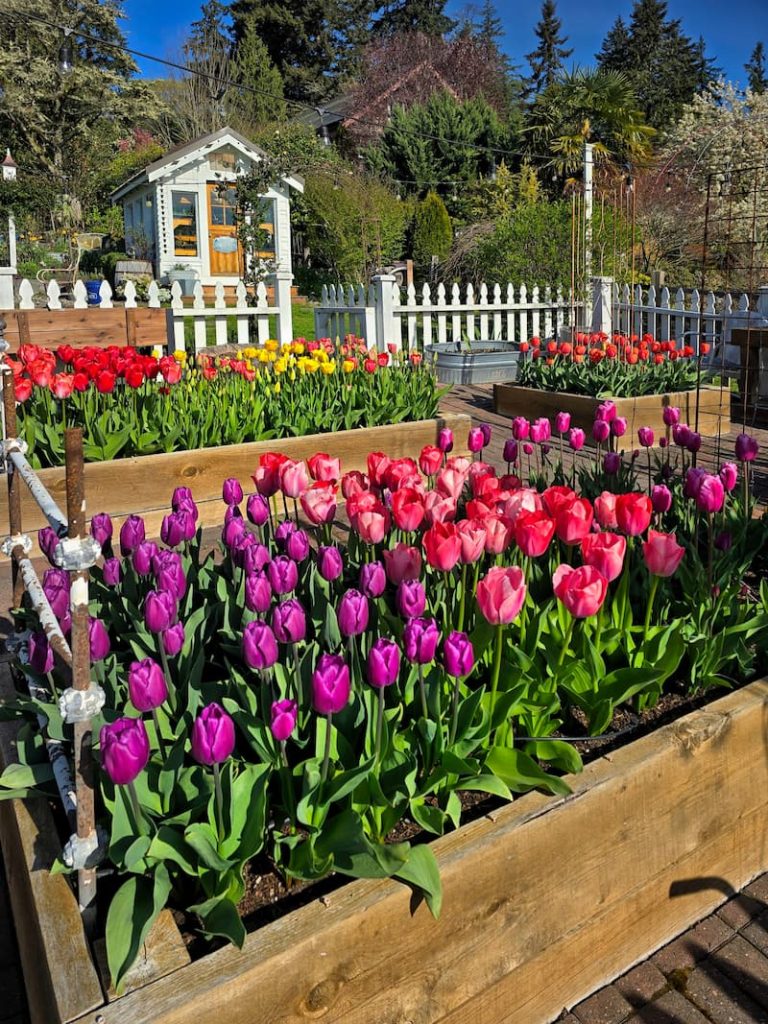
32. Tulips
This cup-shaped blooming classic spring bulb comes in various colors, from soft pastels to vibrant primaries and even multi-colored varieties, allowing for endless creative combinations in garden design.
Tulips are especially effective when planted in large groups or drifts, where their impressive colors can truly make a visual impact.
They prefer cooler climates and well-drained soil. While they are perennials, many gardeners treat tulips as annuals due to their tendency to produce their best display in their first year.
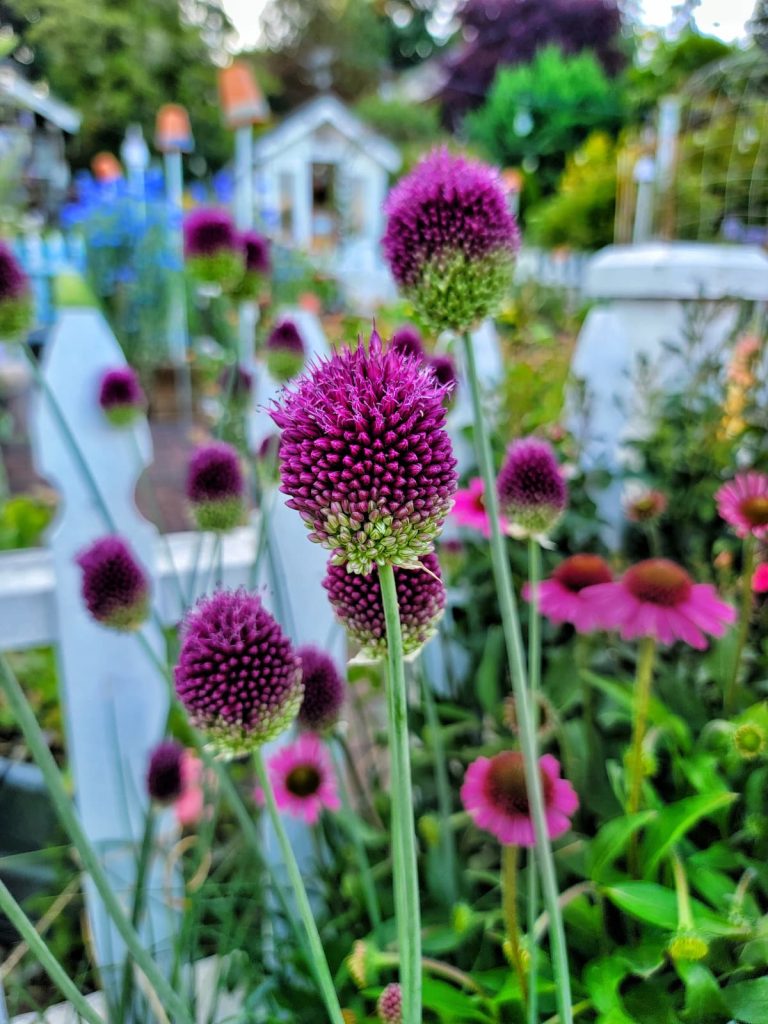
33. Allium
Alliums are one of my favorites to add interest to any cottage garden, with their striking globe-shaped blooms and tall, sturdy stems.
These ornamental onions explode into clusters of small flowers, ranging in color from soft lilacs and whites to vibrant purples and blues. Their bulbs are incredibly easy to grow, thriving in full sun and well-drained soil, and once established, they are drought-resistant.
Allium blooms in late spring to early summer with round, pom-pom-like flowers. They’re deer-resistant and resistant to most other pests, while bees and butterflies love their flower heads. Their seed heads also provide visual interest in the cottage garden, even after the blooms have faded.
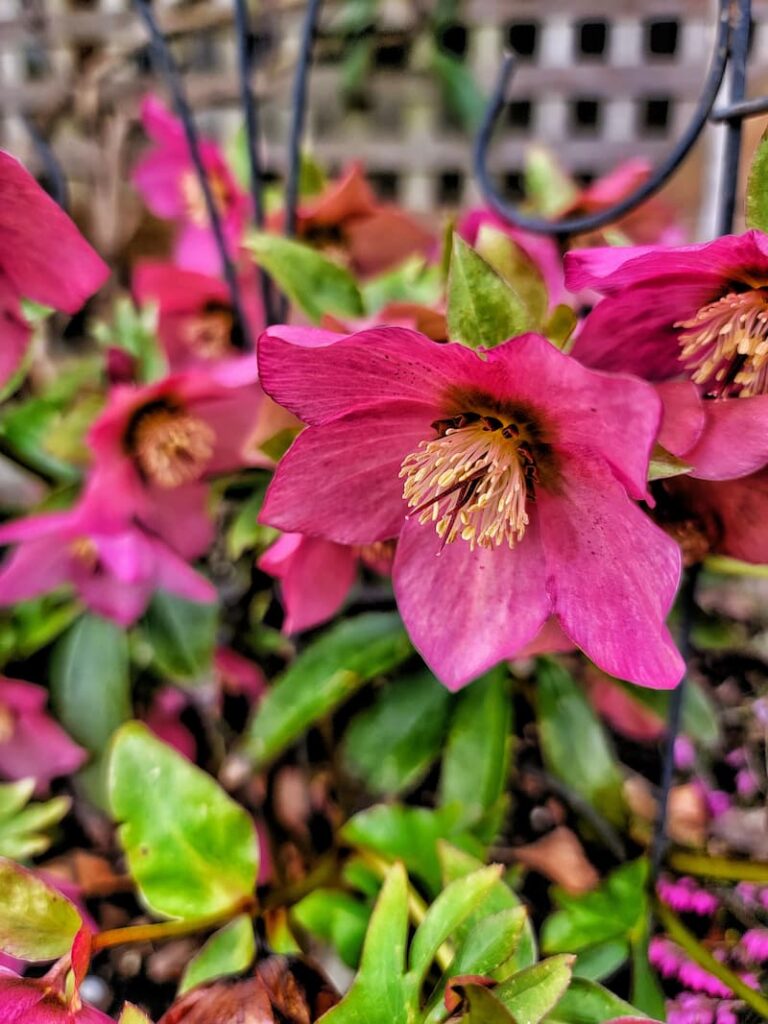
34. Hellebore
Hellebores, or Lenten roses, blend beauty, resilience, and low-maintenance care into the cottage garden. They flower from late winter through early spring, providing color and interest when most other plants are dormant.
These perennials thrive in partial shade and are evergreen, maintaining a lush backdrop of dark green, leathery leaves throughout the year.
Hellebores come in various colors and patterns, from whites and pinks to deep purples and almost blacks. They are resistant to pests and are a practical choice for gardeners wanting year-round beauty with minimal fuss.
Garden Supplies and Tools
Check out my favorite garden supplies and tools for the growing season. Whether you’re looking for potting soil or deer repellent, you’ll find what I use in my own garden.
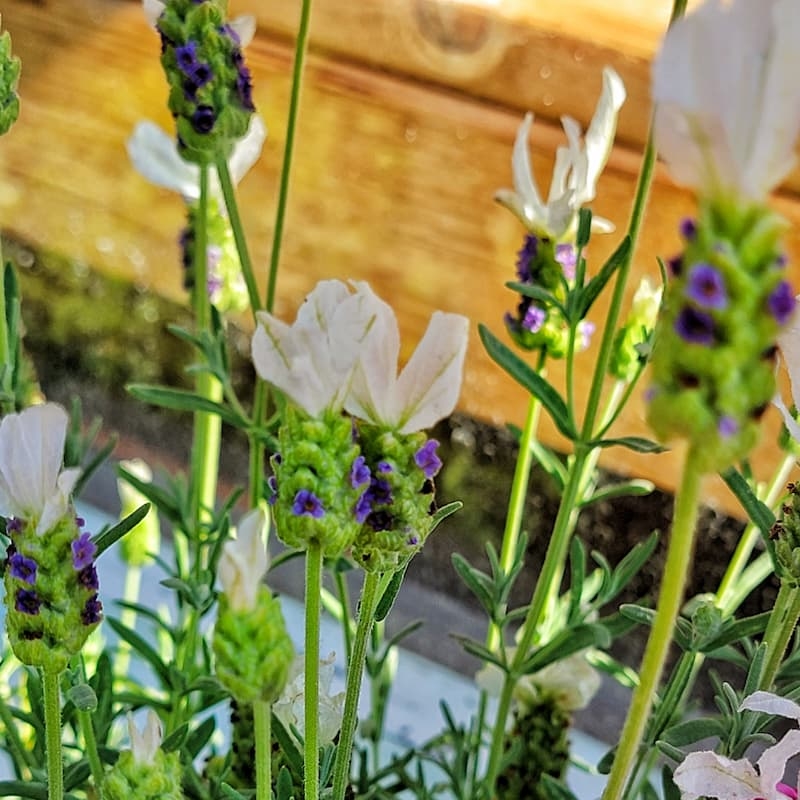
Cottage Garden Plants for Areas of the Garden
When designing a cottage garden, choosing plants that thrive in specific garden areas ensures a lush and vibrant landscape year-round.
Here are some specific cottage garden areas to consider when choosing your plants.
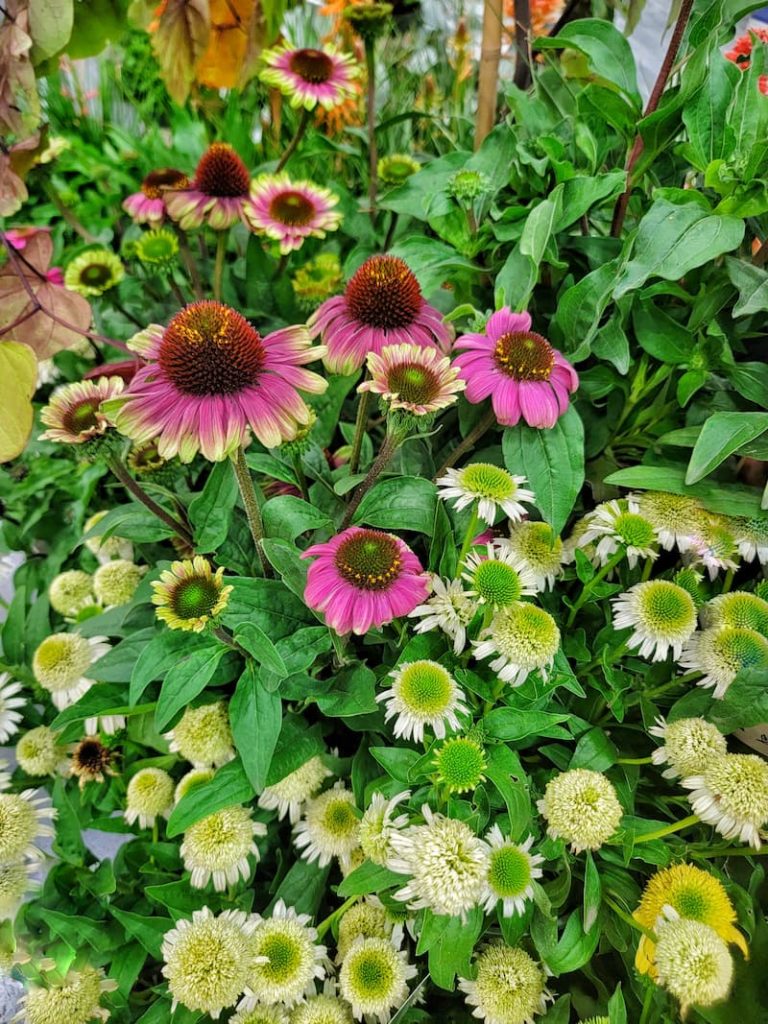
Best Cottage Garden Border Plants
When selecting plants for a cottage garden border, look for species that offer long blooming periods and can thrive under various conditions.
Ideal border plants should be hardy and capable of providing continuous color and texture as the seasons change. They should also be proportionate in height, with taller plants at the back and shorter ones at the front to create a layered, visually inviting effect.
Choose plants that can fill spaces densely, helping suppress weeds and maintain soil moisture while fitting that classic cottage garden’s informal, lush look.
Opt for plants with different blooming times to ensure a lively border from early spring to late fall.
Here are some top choices for cottage garden border plants:
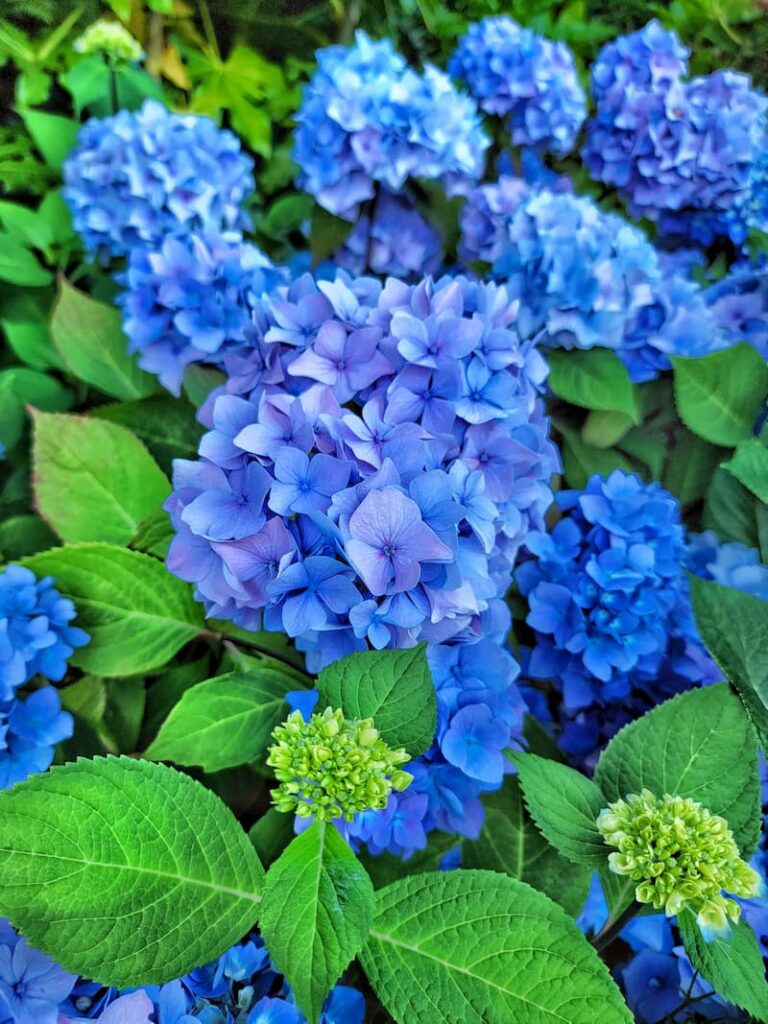
Anchor Plants for a Cottage Garden
When choosing anchor plants for a cottage garden, prioritize those that provide structure and form the garden’s backbone throughout the year.
These key plants should be strong, offering height and breadth to help define the garden’s layout and create visual interest in all seasons.
Look for species with a commanding presence, such as showy foliage, impressive blooms, or interesting architectural forms.
Anchor plants should also be perennials, requiring minimal maintenance once established. They should blend harmoniously with other plants typical of a cottage garden’s informal style.
Here are several excellent choices for cottage garden anchor plants:
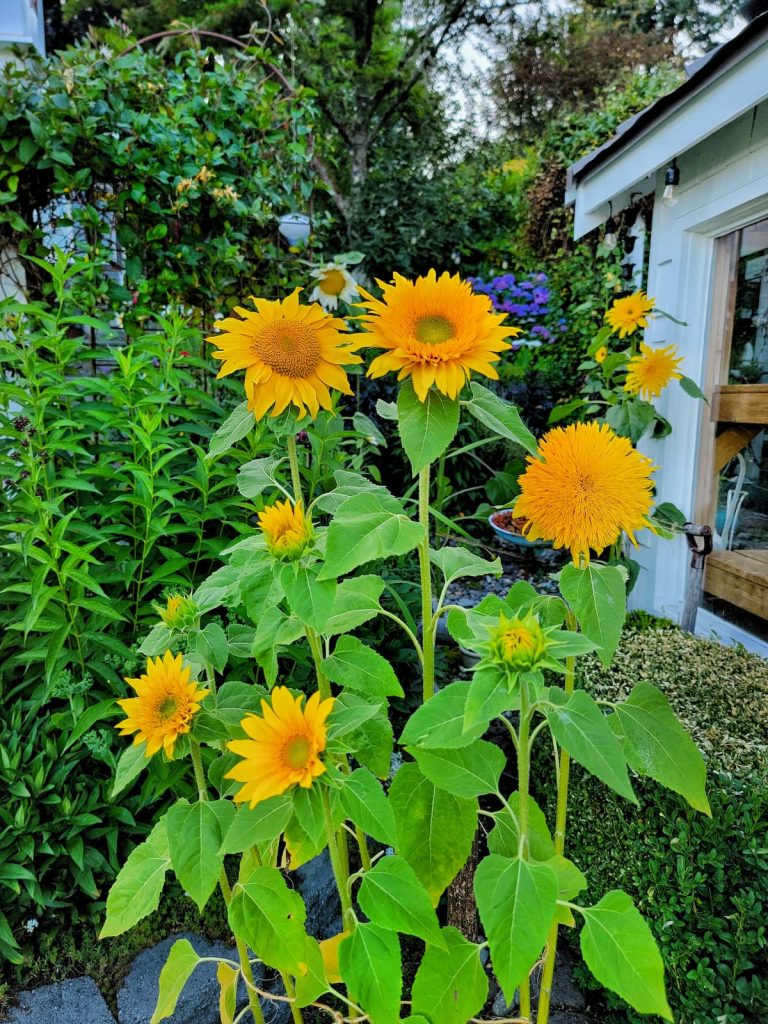
Tall Cottage Garden Plants
In a cottage garden, tall plants are essential for adding vertical interest and creating layers within the garden’s design.
When selecting tall plants, it’s important to consider their growth habits, ensuring they can provide height without overwhelming neighboring plants.
Look for varieties that offer impressive blooms or foliage and can act as natural backdrops or privacy screens. These plants should be robust and able to withstand various garden conditions.
Consider the plant’s bloom time to ensure a succession of flowers and interest throughout the growing season.
Here are some recommendations for tall plants suitable for a cottage garden:
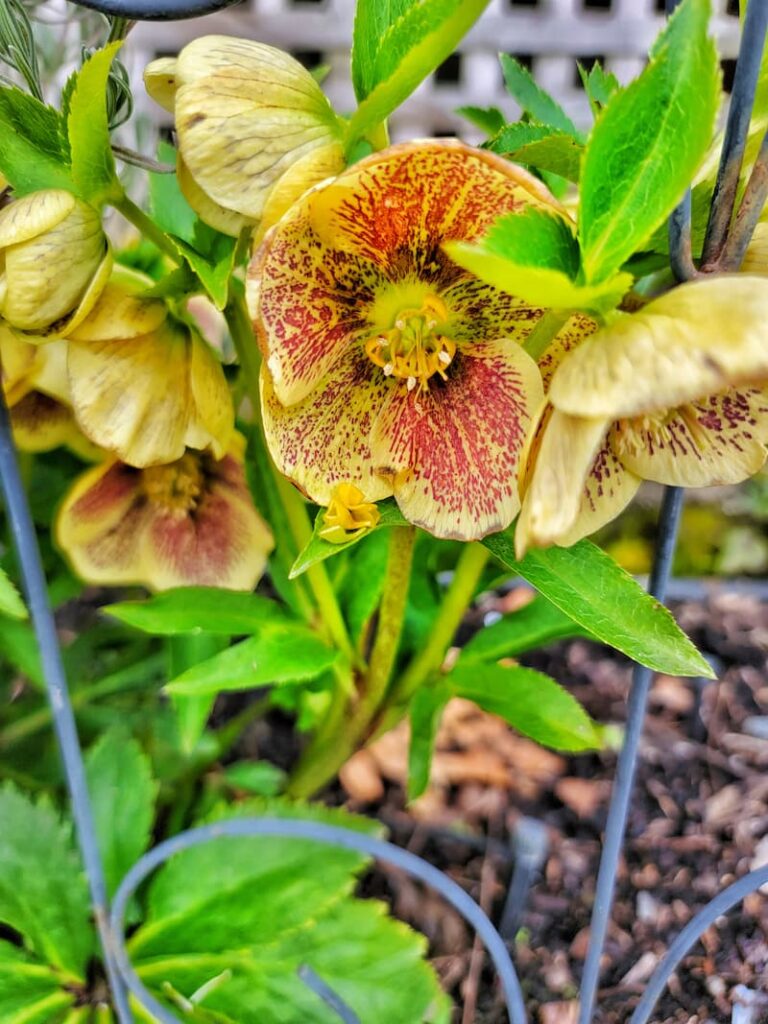
Cottage Garden Shade Plants
Choosing the right shade plants in a cottage garden ensures vibrant, lush growth even in less sunny areas. Look for plants that thrive in partial to full shade and can add texture, color, and interest beneath tree canopies, alongside north-facing walls, or in other shaded spots.
Ideal shade plants for a cottage garden should be able to grow in lower light conditions while still contributing to the garden’s overall aesthetic.
It’s important to select varieties with attractive foliage that can bloom in reduced light, enhancing the visual appeal of these less colorful garden areas. Consider resilient plants capable of competing with tree roots if needed.
Here are some excellent choices for shade plants in a cottage garden:
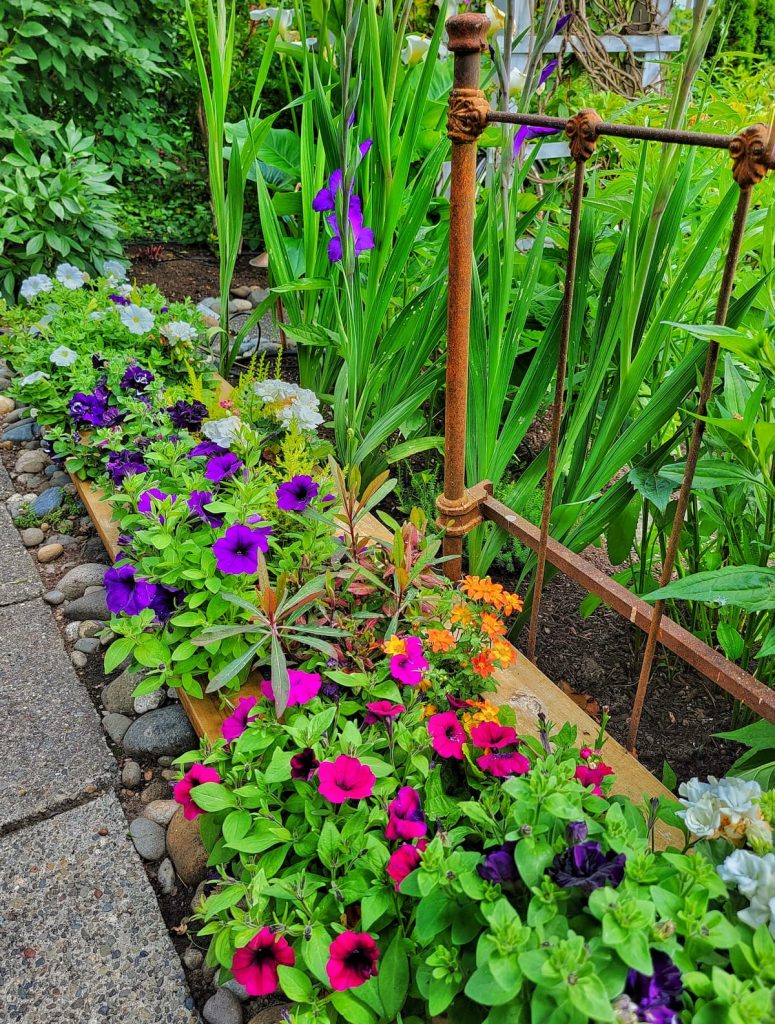
Best Cottage Garden Plants for Containers
When selecting plants for containers in a cottage garden, it’s important to choose varieties that will thrive in the confined space of a pot while still contributing to the lush, informal aesthetic of the garden.
Look for plants that have a compact growth habit yet offer abundant blooms or striking foliage. Consider their water and soil needs to ensure they can flourish in a container environment.
Choose plants that can provide visual interest across multiple seasons through long-lasting blooms, attractive foliage, or interesting textures. Combine plants with varying heights, colors, and blooming periods to create a mini cottage garden in each container.
Here are some ideal plants for cottage garden containers:
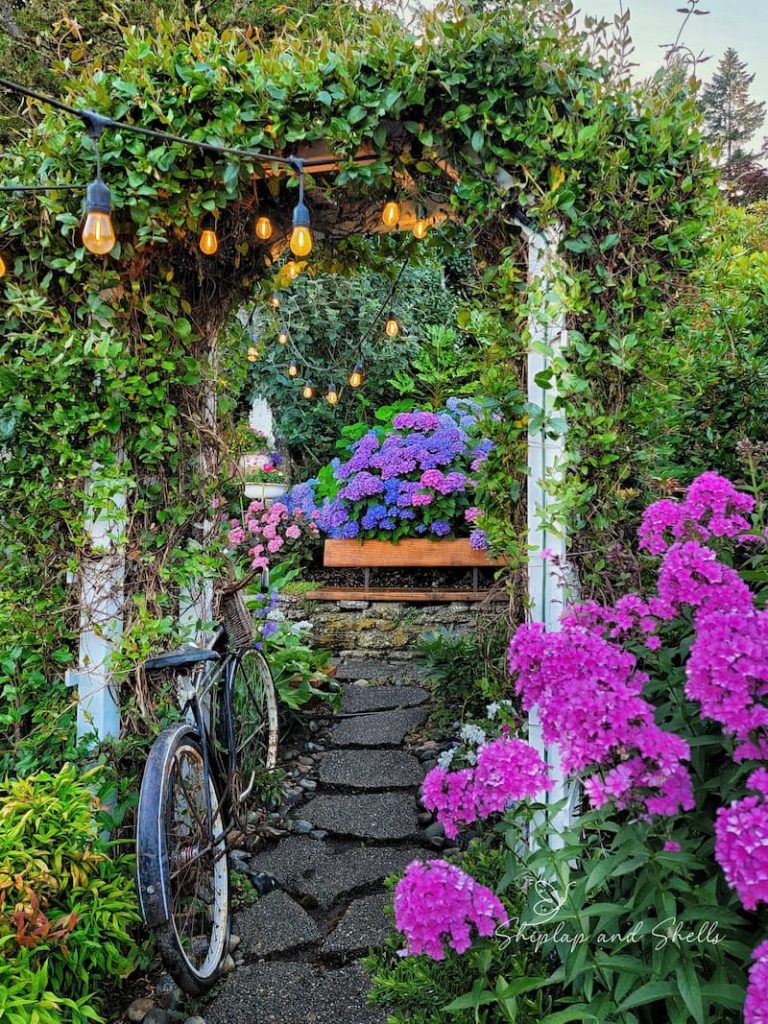
What is a Cottage Garden
A cottage garden is a whimsical, carefree, informal gardening style. Its design embraces an abundance of flowering plants, herbs, and vegetables.
The goal of a cottage garden is to create a welcoming and relaxed atmosphere, similar to a cozy cottage setting. It often features a mix of colors, textures, and fragrances, with plants arranged carefree to create a natural and enchanting feeling.
A cottage garden style is a timeless and peaceful haven with lush blooms, winding pathways, and rustic elements like picket fences and arbors.
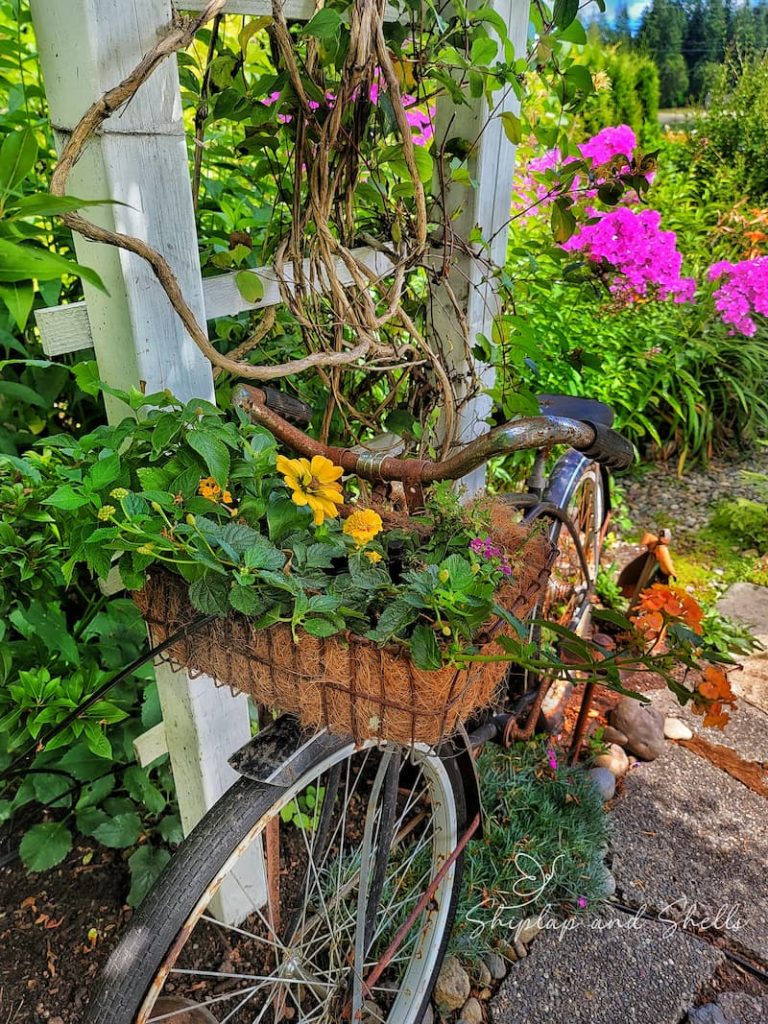
The Importance of Choosing the Right Plants
Choosing the right plants is essential when creating your own cottage garden. By carefully selecting the plants you will grow in your cottage-style garden, you can transform your garden into a captivating and thriving outdoor haven.
Here are some of the reasons why choosing the right plants is important.
Determines the Overall Aesthetic of Your Garden
Each plant brings its unique colors, textures, and shapes, which contribute to the visual mood of the space. You can create a harmonious and stunning design by choosing plants that complement each other.
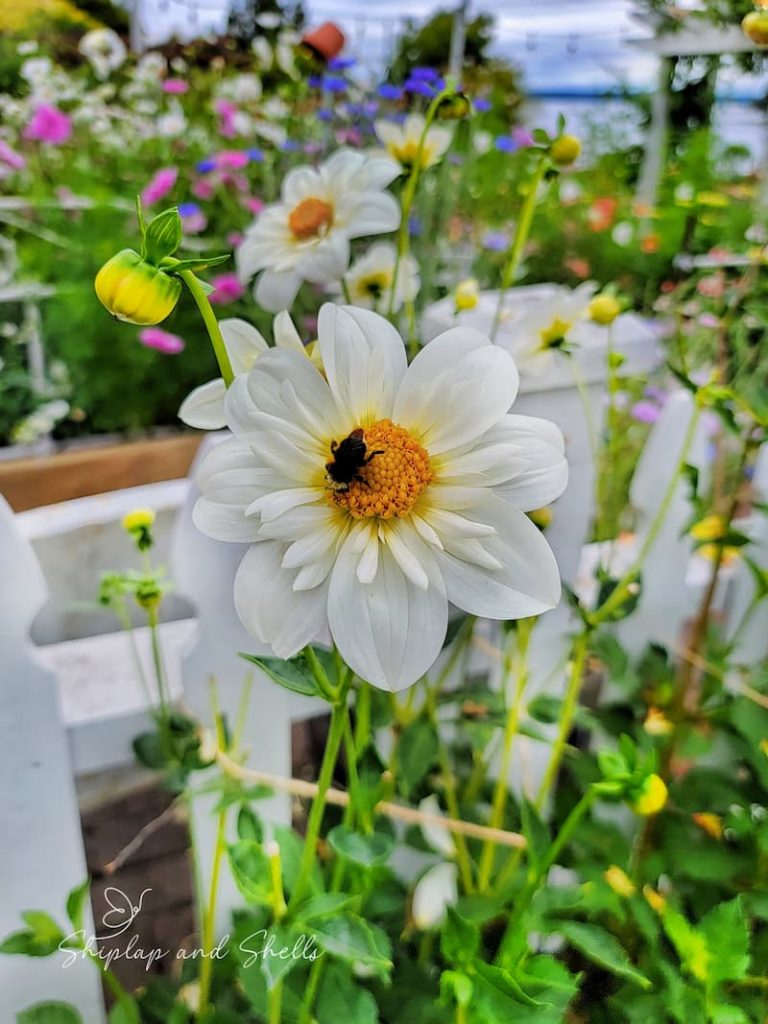
Provides Visual Interest and Balance
Select plants with varied blooming seasons, heights, and growth habits for a continuous display of colors and textures. Diverse plants add visual interest and support a thriving ecosystem with habitats for beneficial insects and birds.
Adapts to the Environmental Conditions of Your Garden
Choose the right plants for your garden conditions, such as sunlight exposure, soil type, and moisture levels. Picking compatible plants improves their chances of thriving and reduces maintenance requirements.
Promotes Sustainability and Ecological Balance
Choosing native or low-maintenance plants helps conserve water, reduces chemical use, and promotes local biodiversity.
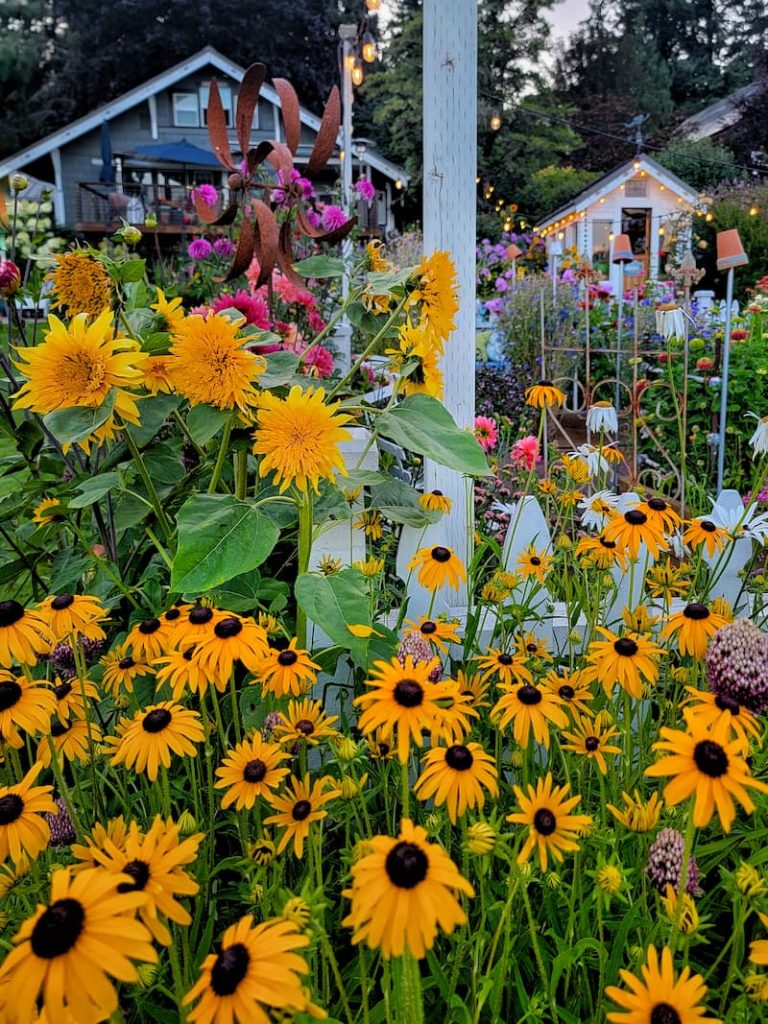
Common Questions About Cottage Garden Plants
What are the Best Plants in Early Summer?
Early summer is a key time for a cottage garden. You’ll need plants that can thrive in full sun and well-drained soil. Peonies, delphiniums, and lavender are three excellent choices. Peonies have large, showy flowers in various colors, while delphiniums produce tall spikes of blue, pink, or purple flowers.
Lavender not only looks beautiful, but it also has a lovely scent and can be used for cooking or crafting.
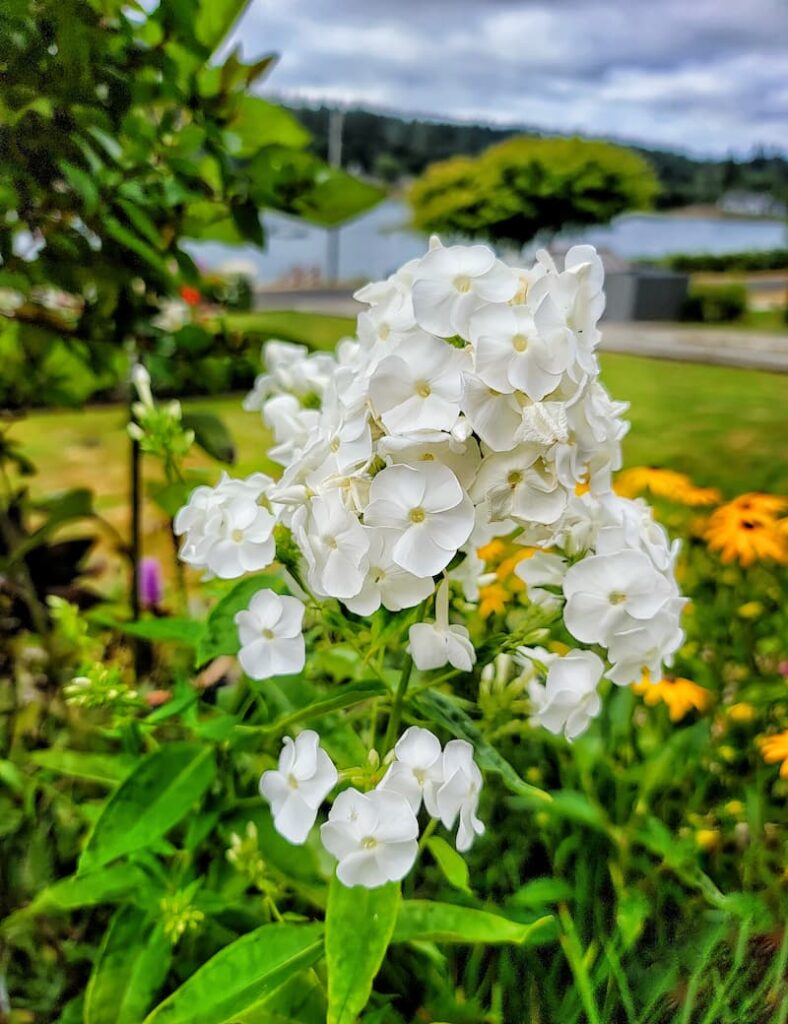
What are the Best Plants for Partial Shade?
Partial shade areas can be tricky to plant, but many thrive in these conditions. For a classic cottage garden look, consider white flowers.
Hydrangeas, lilies, and phlox are all great options. Hydrangeas have large blooms that change color depending on soil acidity, while lilies have white, pink, or yellow trumpet-shaped flowers. Phlox has clusters of white or pink flowers and is easy to grow.
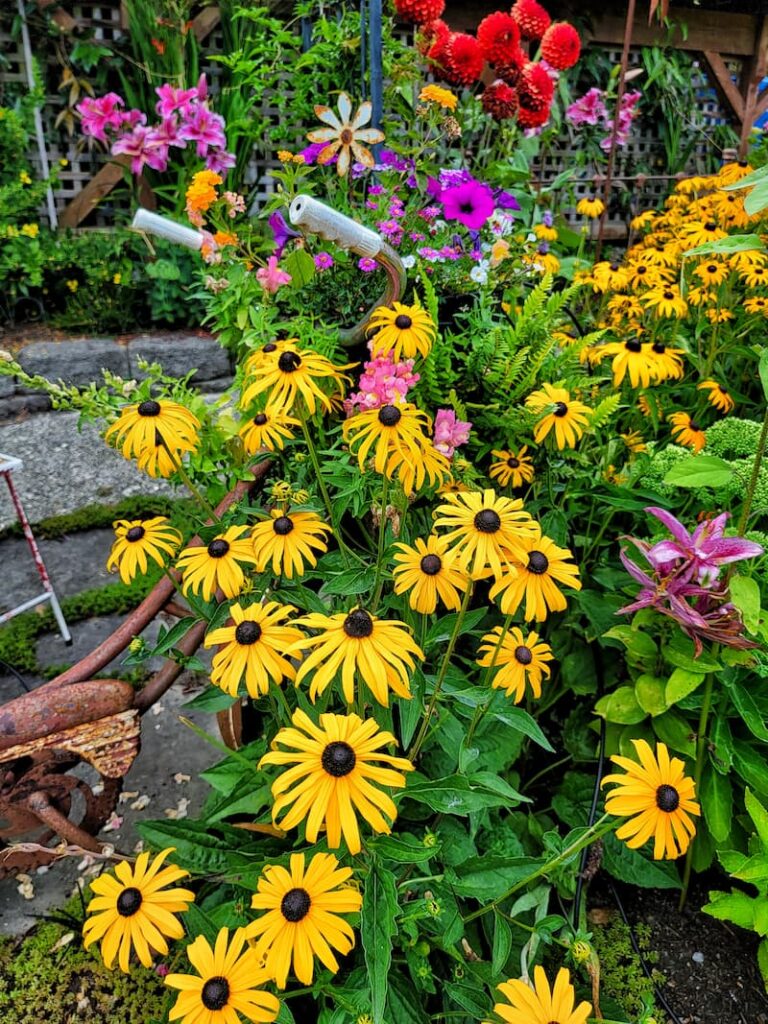
What are the Best Low-Maintenance Plants for the Growing Season?
Low-maintenance plants are ideal for a cottage garden. Black-eyed susans and daylilies are great options for thriving throughout the growing season.
Black-eyed Susans have bright yellow or orange petals and a black center, while daylilies have trumpet-shaped flowers in various colors. Both of these plants have green leaves that add texture to a garden.
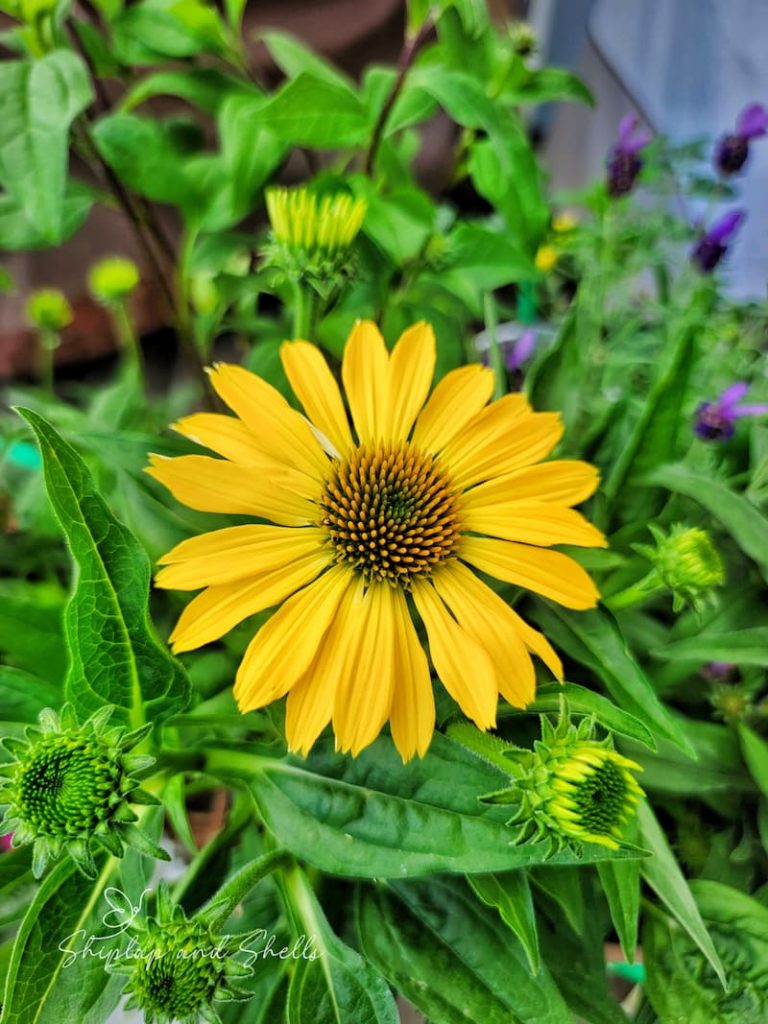
What are the Best Plants for Late Summer and Hardy Geraniums?
Late summer is another important time in a cottage garden. Coreopsis, rudbeckia (black-eyed Susans), and echinacea (coneflower) are three additional plants that thrive in late summer.
Coreopsis has yellow or pink flowers, rudbeckia has golden petals with a black center, and echinacea has pink or purple daisy-like flowers and white, red, and yellow varieties.
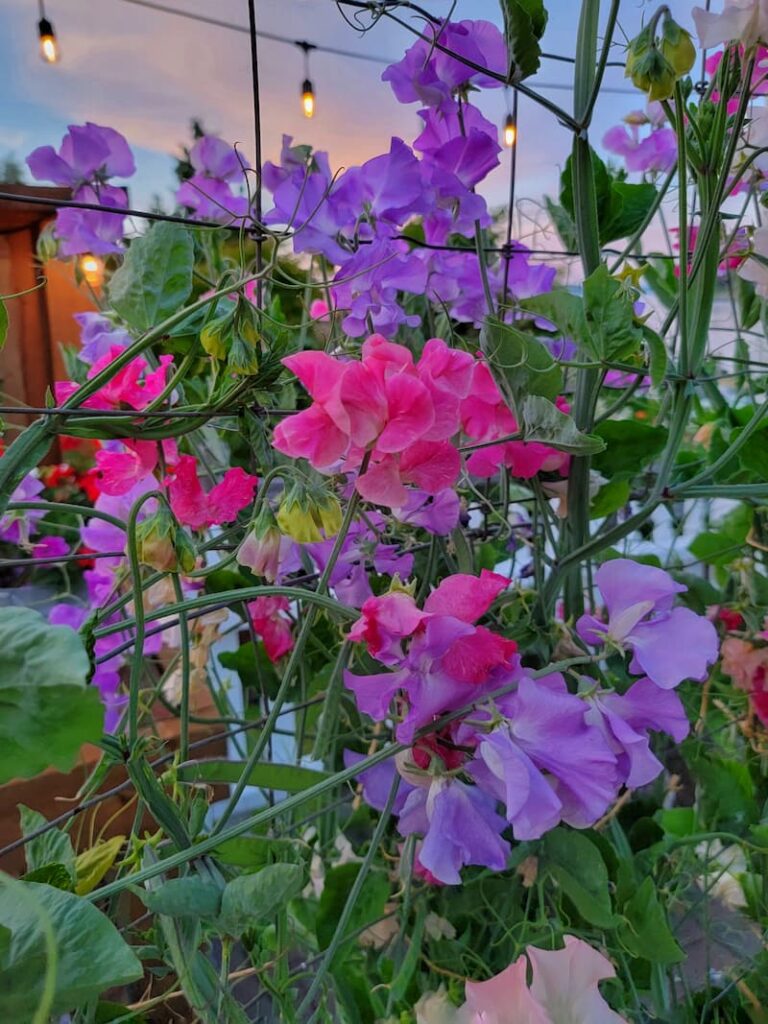
What are the Best Cottage Garden Plants for Small Spaces?
You don’t need a large space to create a charming cottage garden. Sweet peas thrive in small spaces and produce great-cut flowers. They have delicate flowers in various colors that will grow vertically on a trellis or arbor and don’t need much space to grow.
Grow sweet peas along a white picket fence, which is a classic element of a cottage-style garden.
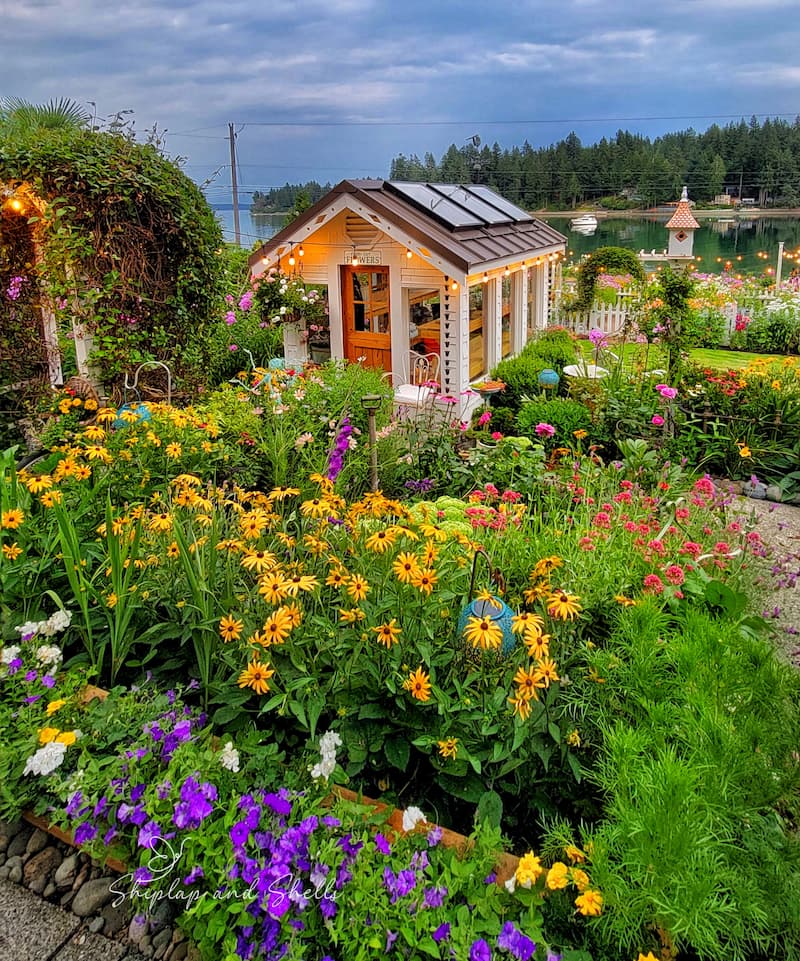
Creating a charming cottage garden is easier than you might think. You can achieve a beautiful garden full of color and texture by selecting the right plants and properly caring for them.
Whether you’re a seasoned gardener or just starting your gardening journey, a cottage garden style is a charming and inviting option.
If you have any questions or additional suggestions, please share them in the comments below. And be sure to share this blog post link with anyone who may find these gardening tips useful.
Until next time,
Happy Gardening!

I’m a self-taught hobby gardener. Everything I share on my blog is my opinion and what has worked for me.
Follow Me for More Inspiration
Shop my Amazon Storefront, LTK sources, and favorite home decor, garden, and lifestyle products. When you purchase from one of my links, I earn a small commission, which helps me continue sharing all the content you expect on my blog.
Be sure to follow me on Pinterest, Instagram, Facebook, TikTok and LIKEtoKNOW.it. Do you like gardening? Join my Facebook Gardening Tips & Tricks group.
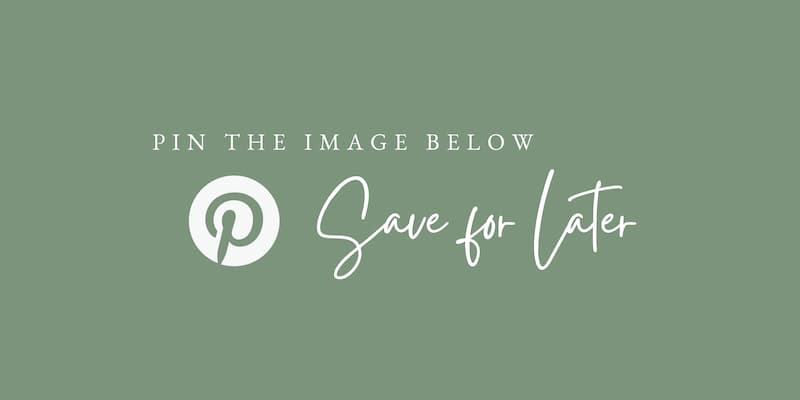
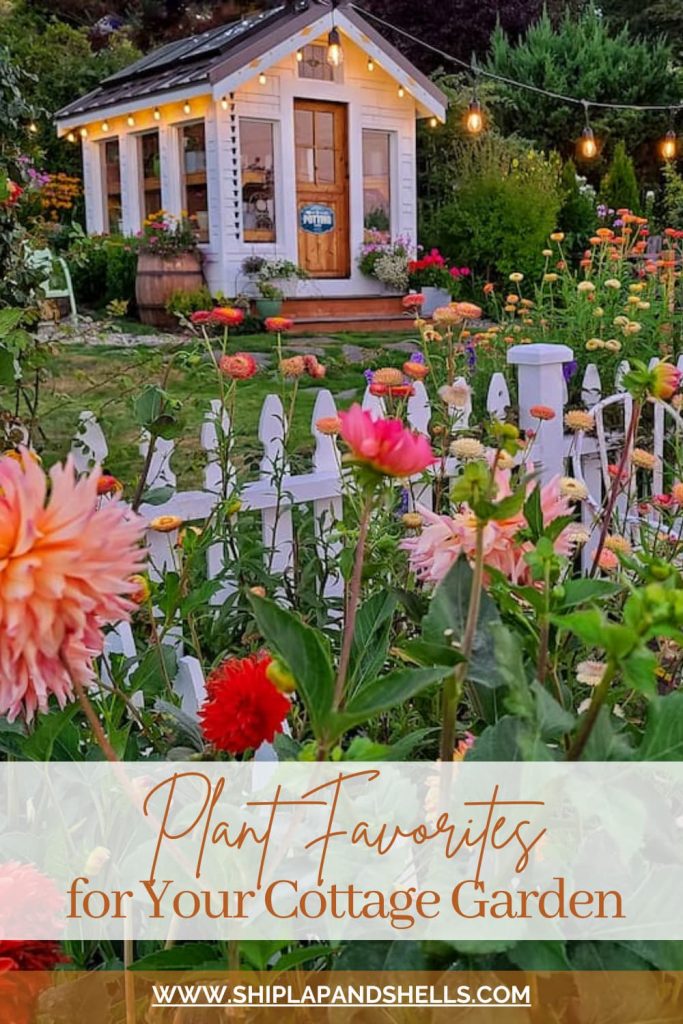

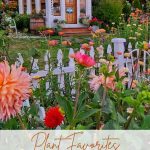
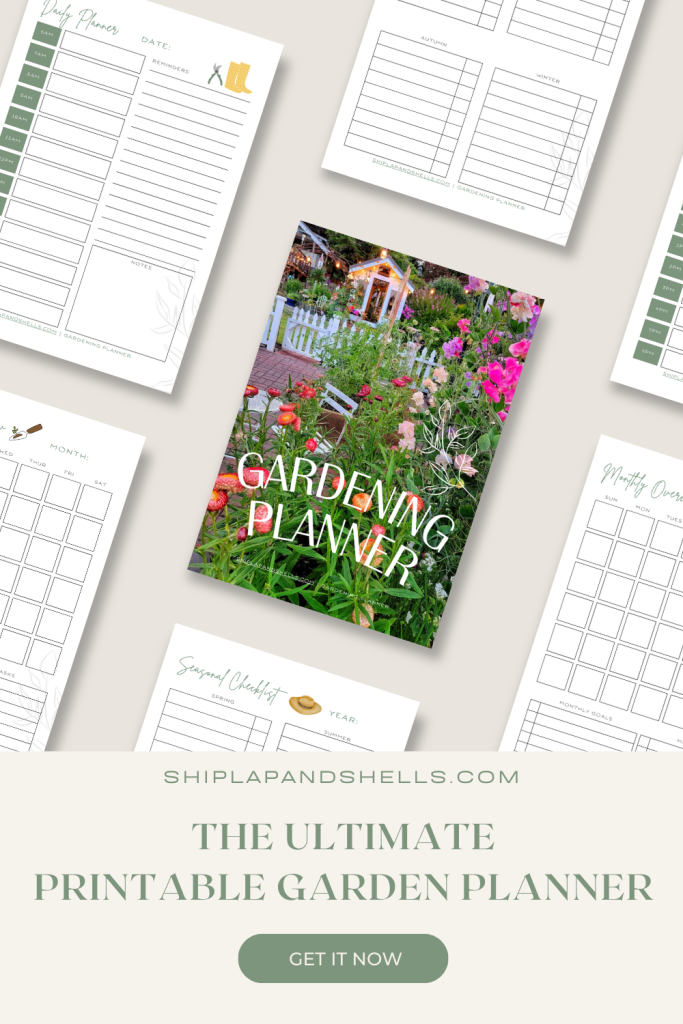
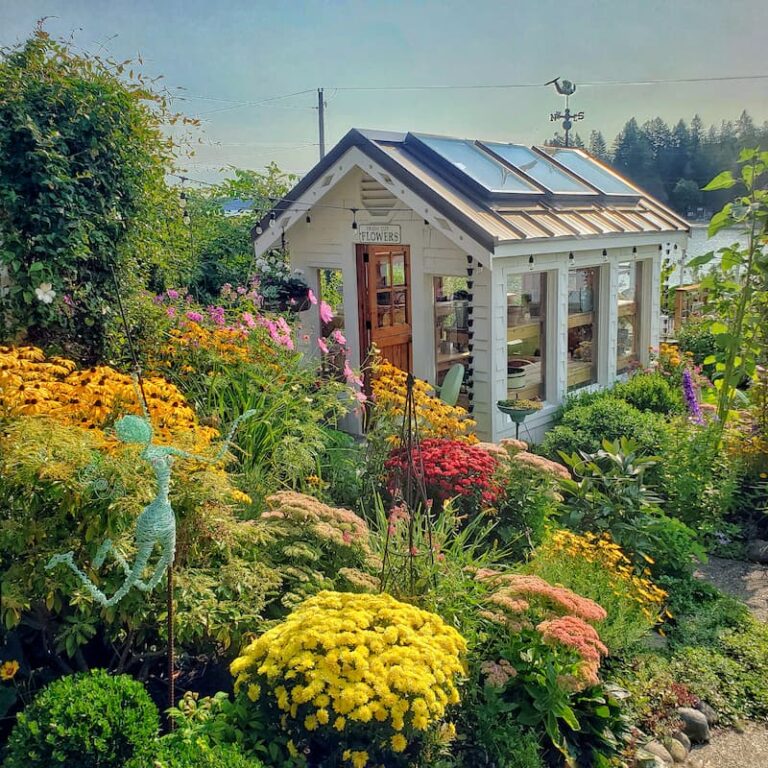
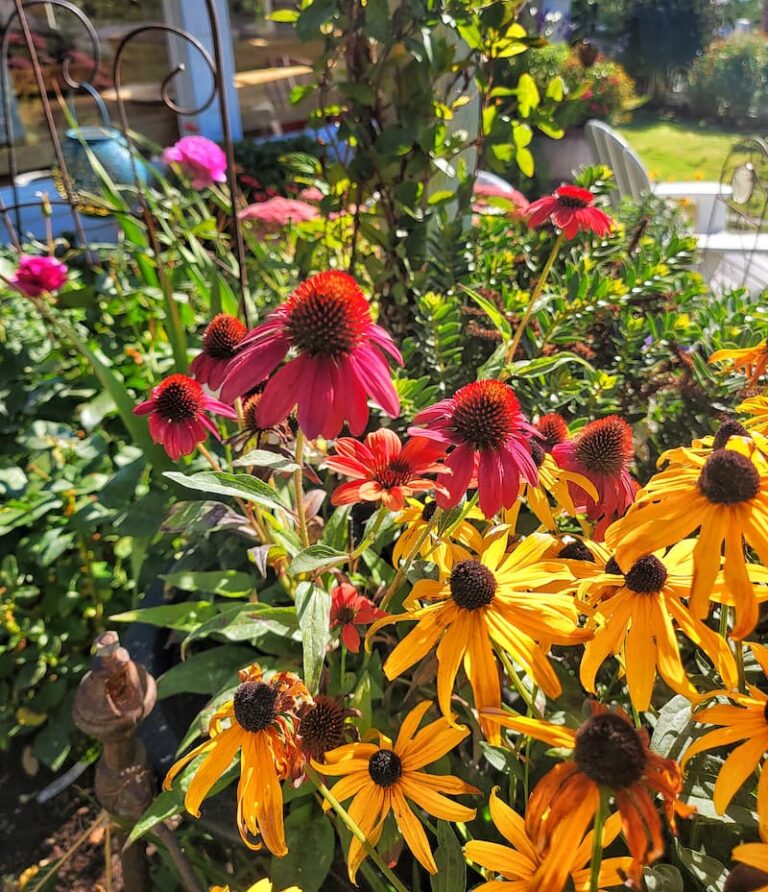
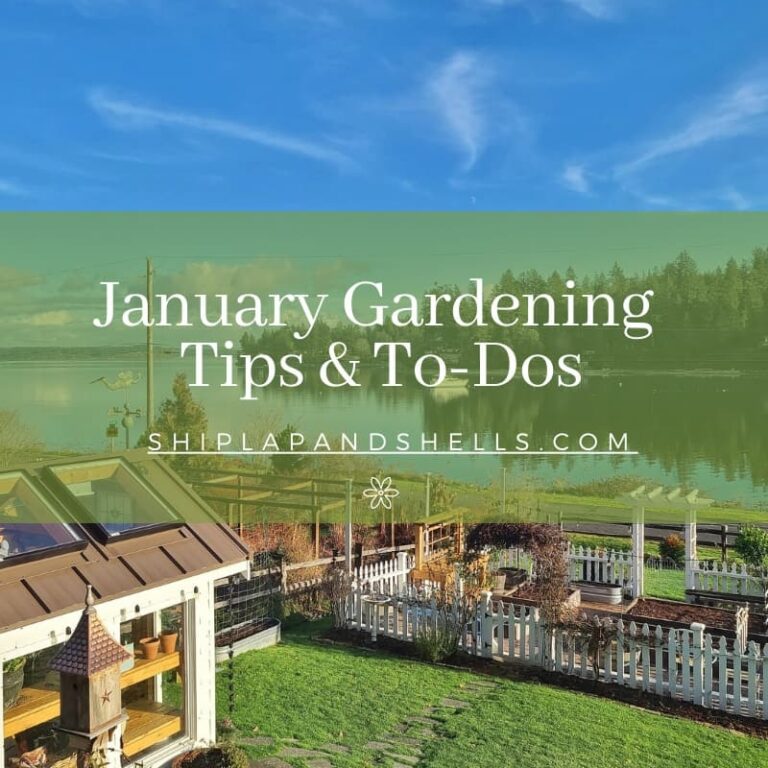
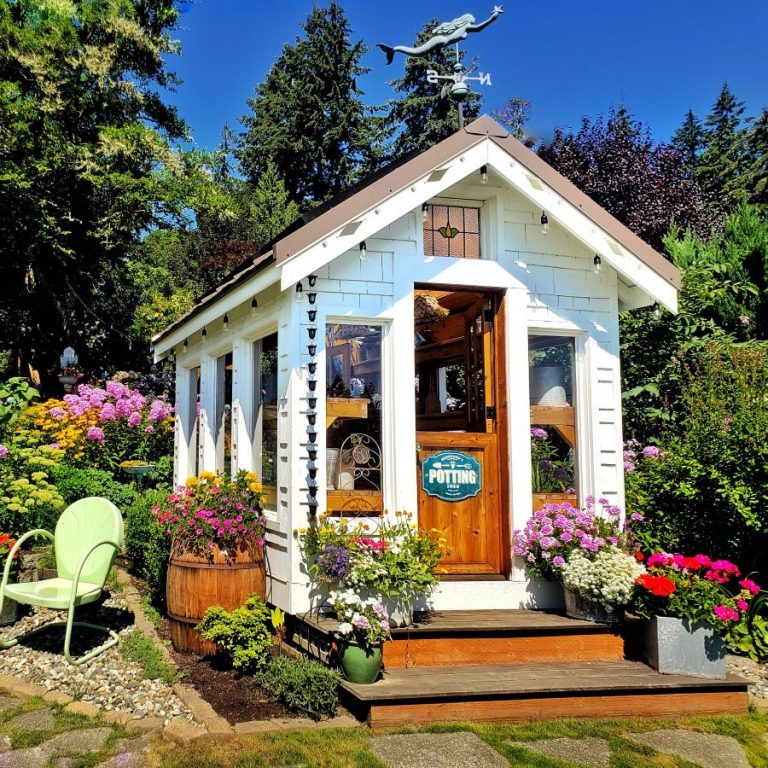
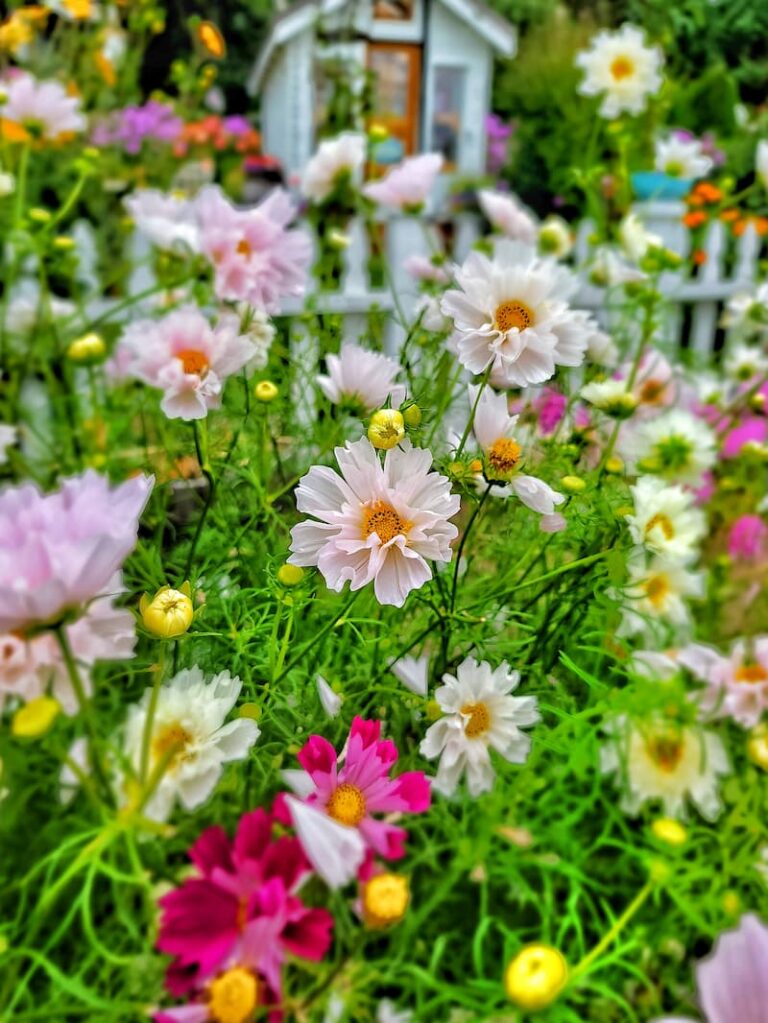
So beautiful Kim! Thanks for the inspiration!
I too love your home and garden and shed. Question or advice, I currently have hard rock dirt in my flower beds (new old home), previous owners left me a bit of mess. Can’t remove all dirt but what can I do? My lavender & calla Lillie’s grow well but want other flowers.
Appreciate any feedback. I’m in Snohomish so also deal with sugar ants! Lol
Thank you
Your home is so beautiful you are a very talented person. I really enjoy and look forward to your articles on Sundays.
Hi Amy!
Thank you for the most wonderful compliment. I’m so happy to have you following along. Hope you’re having a great week!
Kim